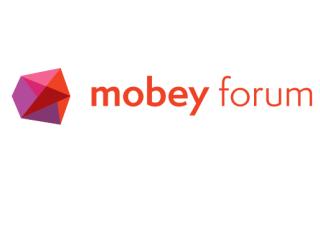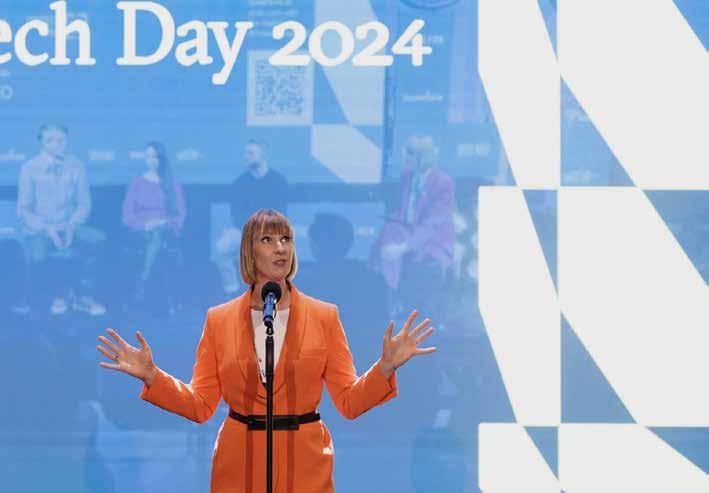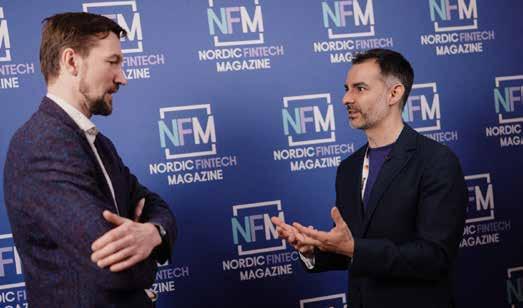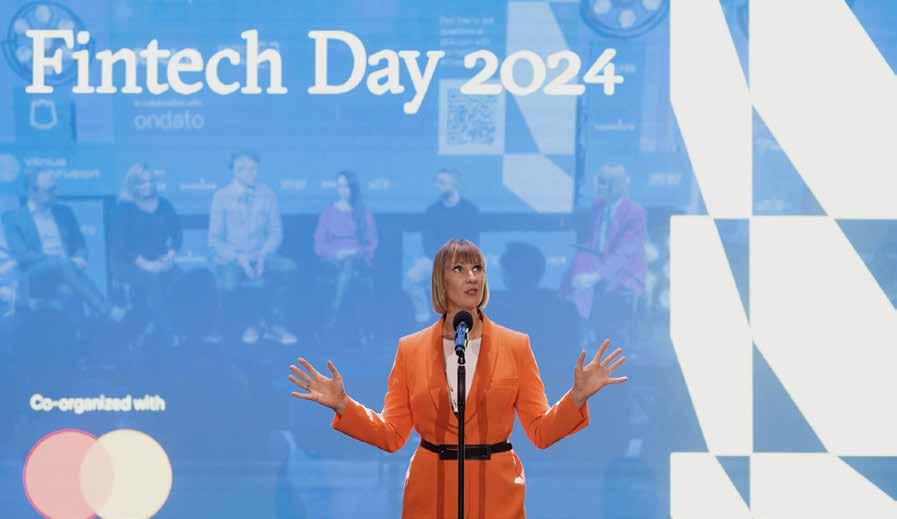

Six Inescapable Trends Stretching the Boundaries of Limitless Payments p. 30-33 From Open Banking to Open Finance: The top 10 Lessons for Seamless Transition Executing Digital Banking Transformation with Fintech Partnerships















Six Inescapable Trends Stretching the Boundaries of Limitless Payments p. 30-33 From Open Banking to Open Finance: The top 10 Lessons for Seamless Transition Executing Digital Banking Transformation with Fintech Partnerships












Nordic Fintech Magazine exclusively works together with selected Nordic Community Partners for insights and distribution, giving us unparalleled reach with audiences across the Nordics and Baltics



Thank you to all the Fintech heroes contributing to this magazine!


























In the first quarter of 2024, Nordic Fintech Magazine embarked on an extensive journey across the Nordics and Baltics to take a plunge right into the pulsating heart of financial innovation. In our quest, we have travelled near and far to places like Lithuania, Norway, Denmark, and Stockholm, where in line with our mission of unlocking transformational ideas, we continue to tap into, and expose some spectacular thought leadership from this innovation rich region. With over 2200 Fintechs sculpting the financial services landscape, the Nordics and Baltics remain a force to be reckoned with in the race for influence in the global Fintech stage.
Throughout our activities in this first quarter, we've engaged with thought leaders and visionaries that are not just able to think bold, but to also think beyond. These interactions fill us with excitement, optimism, and a profound sense of admiration for the ingenuity and resolve with which Nordic and Baltic Fintech entrepreneurs are orchestrating transformative shifts in the industry.
In this issue we’ll cover trends that have captured our attention for their potential and their gravitas as pillars of the ecosystem. We start off by looking at the emergence of identity services and trust. The deep-seated trust in government, systems, and institutions lies close to the heart of our region. This trust made way for the widespread adoption of digital identities, enabling access to a vast array of services, from public sector offerings to financial transactions. We will explore the foundational role digital identity plays in Fintech and the accelerating effect that trust based services can have in the development of novel financial solutions.
Shifting our focus to payments, we witness an evolution spurred by the recent Instant SEPA regulation, marking a stride towards instant payment solutions across Europe. This change, coupled with the advancements in open banking and account-to-account payments, and regulatory shifts like PSR and PSD3 hint towards a more
interconnected future financial ecosystem. Embedded finance further exemplifies this integration, advancing how financial services are seamlessly incorporated into various customer journeys. This phenomenon is not confined to traditional financial companies, but spans across diverse sectors like retail, travel, and healthcare, showcasing the ever-expanding link between financial services and adjacent industries.
Our region's dynamism in Fintech is also evidenced by the vibrancy of industry events, from the exhilarating Fintech Day in Lithuania to the largescale Stockholm Fintech Week and upcoming cutting-edge Norway Fintech Festival, the region is alight with conferences. These gatherings are not just networking opportunities but also fertile grounds for sharing ideas and expanding collaborations that fuel the sector's growth. And Nordic Fintech Magazine, has been and will continue to be there at the center of the action to cut through the noise and bring you front row access to the sharpest thinking in the industry.
An intriguing narrative that we’ve stumble upon as we try to understand the forces shaping Fintech in 2024 is the rise of financial services innovations emerging from unconventional quarters, notably retail. We observe developments that are responses to unmet needs in integrated solutions encompassing data management, artificial intelligence, and payment systems, revealing a trend of self-driven innovation among non-traditional financial players.
The pace of change in our ecosystem is relentless, with AI playing a transformative role in both the backend and frontend of financial services. Up to 46% of new code is now generated by AI, resulting in a 55% increase in overall developer productivity and highlighting a significant shift towards automation in software development. The integration of generative AI is to revolutionize the sector, streamlining foundational processes and unleashing potential for new value propositions, business models, and problem-solving methodologies.
While we embrace the rapid pace of innovation, we also value the careful consideration needed for its practical application and broader acceptance. Indeed, novelty brings excitement and the potential to transform longstanding practices. However, we understand that in our industry, successful innovation has always depended on the resilience and reliability of a robust infrastructure. This infrastructure, having served over 33 million people across our regions for years, is secure, sturdy, and dependable. It forms the essential backbone that supports the mission to
 Chris Crespo Chief Editor & Head of Content at Nordic Fintech Magazine
Chris Crespo Chief Editor & Head of Content at Nordic Fintech Magazine
make financial services more accessible, convenient, and adaptable. This ensures that finance not only fulfills its fundamental purpose but also extends its reach to offer improved, more accessible services for everyone. In this issue, we celebrate both the visionaries who introduce new possibilities and the dedicated individuals who have built and maintained the necessary foundations that enable these advancements.
In a recent discussion with Thomas Jul, CEO of Inpay, we explored the challenges faced by international organisations when moving money across borders. We talk about the operational and regulatory complexities that arise when transferring funds across jurisdictions and the impact these can have on business operational efficiency and costs.
 By Chris Crespo
By Chris Crespo
Global commerce hinges on the ability to transfer money efficiently and securely to suppliers, customers, and partners. Regional international payments in areas like the EU have benefited enormously from the common regulatory frameworks and infrastructure that enable transactions to happen quickly and with full traceability. Yet, businesses worldwide struggle with a variety of obstacles in crossborder payments beyond regional jurisdictions. “Transferring money from Germany to Spain can be done as an Instant SEPA payment, but moving money from Germany to Bangladesh can take weeks” says Thomas Jul, CEO of Danish headquartered payment frontrunner Inpay. These challenges originate from varying regulations, complex compliance demands, and disparate technologies. In less developed regions, transactions can become hampered by inefficient banking infrastructure and opaque financial processes, leading to delays and uncertainty. This problem is particularly acute in sectors where time-sensitive operations are common. To circumvent these all-too-
common problems, Inpay has devised a “smart routing” approach that allows it to transfer money across jurisdictions with unique precision and efficiency. Reflecting on the significance of this innovation, Jul states, "smart routing is a strategic asset that combines technology, network and compliance allowing us navigate the diverse landscape of global payments with speed and reliability.” Opening new corridors across the world requires a thorough understanding of local regulations and the local financial landscape. “Smart routing is the backbone of our operation, through which we fine tune each transaction to meet the specific needs and regulations of its destination” Jul adds.
Under Jul’s strategic guidance, Inpay has carved a specialist niche in the often-crowded world of crossborder payments. The company distinguishes itself through a dual-focus approach, combining technological innovation with a deep commitment to customer relationship building. “We don't believe that a transaction is transactional, we think it's the start of a partnership.” Jul asserts. By transforming transactions into the foundation of sustainable
business relationships, Inpay has managed to stand out in the highly competitive marketplace of financial services, building trust and loyalty among its customers.
Delivering against bespoke customer needs
Inpay’s growth can in many ways be attributed to its laser-focused belief that any successful payments provider needs to absolutely understand and solve the specific problems of the sectors it serves. Sector-specialism has therefore become baked into the way it operates.
‘’Our product and commercial teams aren’t split by the product they are selling’’, states Jul ‘’…but by the sector they are serving. This is critical in making sure we provide our customers with the expertise needed to solve their very specific pain points.’’
This belief in the power of specialised service can work regionally too. As Jul states ‘’We knew that our banking customers in the Middle-East had a very different set of demands to those in Europe. For a start, we know that to service that market as well as we could,




we absolutely needed feet on the ground, and we absolutely needed face-to-face contact. So that’s what we did, with a local presence established in Dubai specifically to cater to this.’’
This customer-driven approach can also be seen in the way Inpay understands and addresses complexities in the shipping and NGO sectors, where a set of very specific needs exist. The company's swift, transparent, and secure payment solutions mitigate the adverse effects of delayed transactions in the shipping industry, where timing is often directly linked to significant operational and financial outcomes.
"A container ship can't wait outside harbour for three weeks” stresses Jul, as he explains how delays in cross border payments have significant repercussions in efficiency, costs, and supply chains.
NGOs also encounter distinct financial challenges in cross-border payments, including high standards of accountability, the need for comprehensive documentation, and the demand for secure, transparent transactions. Inpay's response to these challenges is comprehensive, offering services that provide the necessary speed, transparency, and security.
Inpay's foundation is deeply rooted
in addressing complex payment scenarios. Originating from the founder's challenge of donating to Myanmar during a crisis, Inpay was born out of the necessity to navigate the intricacies of international money transfers, particularly in situations where traditional banking fails. This origin story highlights a key focus on 'complex corridors', that demand more than standard transaction processes due to regulatory, logistical, or compliance complexities.
“Inpay excels in these complex cases by starting with a clear understanding of the customer's needs and the specific challenges they face." Jul explains. In the case of NGOs like the Red Cross, which struggle to transfer funds to remote or restricted regions, Inpay connects the dots while addressing the deep causes of the problem. This involves rigorous compliance checks, including KYC processes, and innovative solutions like creating a whitelist of approved recipients to ensure funds are delivered securely and transparently.
Inpay's approach is to strategically develop its network to tackle such complex scenarios head-on. By prioritizing hard-to-solve cases, Inpay has positioned itself as a partner capable of providing bespoke solutions that standard payment processors might not offer. This customer-centric approach, coupled
with Inpay's technological capability, enables it to open new corridors demonstrating its commitment to solving what may seem 'unsolvable'.
Inpay sets itself apart with exceptional completion rates for transactions, a crucial metric for measuring the efficiency and reliability of payment platforms. Jul highlights that, unlike many in the industry where completion rates often falter, Inpay consistently achieves over 99% completion each month. This industry leading performance is particularly impressive considering the complex nature of transactions it specialised on, which traditionally have a higher likelihood of failure.
One of Inpay's standout features is the implementation of the 'four eyes principle,' which allows customers to mandate a dual-approval process for transactions, reinforcing security and oversight. This principle, akin to two-factor authentication in digital security, ensures that every financial transaction is subject to thorough verification, enhancing the accountability and transparency that companies require. “Partnerships are significantly strengthened with the introduction of the 'four eyes principle', a meticulous process that necessitates dual approval for every payment for customers that want it."
Jul explains.
This initiative by Inpay is especially pivotal in the context of organisations with operations in regions where traditional banking and payment systems are either inadequate or entirely absent. Here, the challenges are not just logistical but deeply linked to regulatory compliance and the imperative need for transparency.
Moreover, Inpay’s commitment to speed in transaction processing does not compromise its dedication to security and detailed financial oversight. This balance ensures that organisations that need to move money across borders, meet their operational demands swiftly without sacrificing the integrity
of their financial transactions. By addressing the unique needs of organisations operating in challenging environments, Inpay empowers them to manage transactions with an unprecedented level of confidence and precision, enabling them to focus on their core mission.
“Inpay heavily relies on partnerships to navigate the complex global payments landscape”, Jul emphasizes. The company partners with a variety of entities, including traditional banks, PSPs, and regional/global license holders, to enhance its network's reach and efficiency. These partnerships are crucial for maintaining high completion rates and for Inpay's ability to deliver funds seamlessly and at speed across borders. “By working closely with partners who possess complementary capabilities and licenses, Inpay ensures compliance, safety, and transparency in its transactions." Jul adds. This collaborative approach not only expands Inpay's operational capabilities but also reinforces its commitment to solving the challenges of international payments.
Inpay, under Jul's leadership, is actively redefining the standards of cross-border financial transactions. By prioritizing customer relationships, leveraging technological advancements, and nurturing strategic partnerships, Inpay is not only solving present-day challenges but also shaping the future of global commerce and finance. “Looking into the future, the old world of SWIFT with many links on each payment chain will be replaced with networks of partnerships that work together to deliver money globally as quickly, safely transparently as you would expect in a local transaction” Jul concludes.

As the financial industry evolves from Open Banking to Open Finance, the journey is fraught with technological, regulatory, and strategic challenges. However, this transition offers unprecedented opportunities for innovation and growth. Drawing from my experience with Nordea Open Banking, here are ten invaluable lessons that can illuminate the path to successful Open Finance implementation.
Open Finance ushers in a technological revolution, moving from batch processing to real-time data access. This leap forward enables the creation of innovative products and solutions, transforming how we think about financial services.
Imagine offering products that leverage real-time financial data, enhancing customer experiences and operational efficiency.
Setting clear objectives is crucial. Begin by outlining your commercial goals and regulatory requirements under the Financial Data Act (FiDA). Integrating these aspects from the start ensures that your strategy remains flexible and robust against evolving regulations, preventing the need for a complete overhaul down the line.
Inspiration for Open Finance can be found beyond the banking sector. Initially, we looked towards tech giants like Oracle and Microsoft. Today, innovators like Nordea, BBVA, and Deutsche Bank provide valuable blueprints for API marketplaces. Examining their successes and approaches can offer insights into creating a competitive Open Finance ecosystem.
The importance of management‘s understanding and support cannot be overstated. Early and ongoing education ensures long-term commitment, enabling informed decision-making and resource allocation. This foundational support is key to navigating the complexities of Open Finance implementation.
An internal evangelization strategy is essential to spread knowledge and enthusiasm about Open Finance across departments. Collaboration between various expertise areas can lead to groundbreaking solutions, ensuring that the initiative‘s benefits are fully leveraged.
Given that the implementation journey can span years, recognizing milestones is vital to maintaining motivation. Acknowledging achievements helps sustain engagement and enthusiasm, crucial for navigating the long-term challenges of Open Finance adoption.
The regulatory landscape and market demands are ever-changing. An agile approach to your implementation plan allows for timely adjustments, ensuring your projects remain relevant and compliant. This flexibility is crucial for staying aligned with both regulatory expectations and user needs.
Listening to users from the outset guides product development in a direction that meets market needs while avoiding regulatory pitfalls. Early and continuous engagement with users is instrumental in refining your offerings and ensuring they resonate with your target audience.
"Don‘t just build it and they will come.“ A comprehensive launch strategy is necessary to capture early market interest and valuable feedback. This involves a mix of community management, customer support, and targeted marketing efforts to ensure your product reaches its intended audience effectively.
From the MVP stage, consider who your product is for and how it can meet their needs. This proactive approach allows you to begin commercialization efforts early, targeting users who will benefit most from your initial offerings and setting the stage for broader adoption as your product matures.

In conclusion, transitioning from Open Banking to Open Finance is not just about compliance or technological upgrades; it‘s about reimagining the future of financial services. By applying these lessons, we can navigate the complexities of Open Finance, creating products that are not only compliant but also highly valued by customers. The journey ahead is promising, and with a strategic approach, we can unlock the full potential of Open Finance for businesses and consumers alike.
Mantvydas Štareika is the CEO of CapitalBox, a leading fintech lender for small- and medium-sized enterprises (SMEs) throughout Europe. Headquartered in Finland, the pure fintech company has offices in Sweden, Denmark, the Netherlands, and Lithuania. CapitalBox’s financing solutions are flexible and accessible, and provided by mixing lending tools to make financing both secure and responsible. In this interview, Mantvydas chats about his journey to CapitalBox CEO, how SME lending is being upended by fintech, and where the industry is heading.
Interview with Mantvydas Štareika, CEO of CapitalBox
What is CapitalBox, and where do you fit into it?
Essentially we provide SMEs with loans that meet them exactly where they are in their financing journey, and with the amount of capital they require to not just stay afloat but grow. We’re able to dispense loans within a matter of hours, accept more diverse criteria as collateral, and provide more personalised attention to our clients.
SMEs are often overlooked by traditional banking institutions because of the element of risk involved. These banks are often weary of giving SMEs the capital they need, and that’s led to an enormous SME funding gap in Europe. That gap amounts to roughly 400 billion euro in the E.U. alone. To say there’s a market for alt lending to serve this is putting it lightly, and that’s exactly what CapitalBox is doing.
What was your professional journey prior to CapitalBox?
It was an interesting one, to be sure. My educational background happens to be in law. I entered fintech in 2007 when I joined Coface, eventually
working my way up to CEO. Coface provides credit insurance to businesses, and it was a crash course in credit lending and crisis management via the recession and banking crisis of the late 2000s and early 2010s. As CEO I focused on consolidating and relaunching entire divisions to optimise the company from top to bottom.
I integrated AI and data information systems. I later joined SME Bank as a board member and as CEO, and that was my springboard into CapitalBox in January 2023.
So you’re a little past the one year mark. What have you accomplished in that time? How has the company changed during your tenure thus far?
Hitting the one year mark is a crucial milestone for any executive. You’ve had time to try out certain things and let ideas percolate, but it’s still, relatively speaking, early days. I’m very proud of the expansion efforts I’ve spearheaded in the last year, including launching a new branch in Denmark with a team of Danish market experts. We’ve done some recruiting

and expanded our C-suite. On top of that, we’ve also introduced collateral loans ranging from €500,000 to €3,000,000. Finding a way to offer collateral lending was a major priority from the moment I arrived, and to see it implemented and chugging along at the one-year mark is a big accomplishment for me personally and for the company at large.
Tell us more about this emphasis on collateral lending, and where that fits into the underfunding gap you described.
Everything we do, as far as I see it, is about addressing this underfunding gap, including collateral lending. Closing that gap is the overarching goal. SMEs make up 99 percent of European companies, so no matter how you slice it, SMEs are indispensable to the European economy. The natural next question is, of course, why is the backbone of the European economy underfunded 400 billion euros? Our initial approach with CapitalBox focused on digital sales and small loans for working capital.

We've since realized the need to offer larger investment loans securely, which led us straight to the introduction of collateral lending. Collateral lending creates the security necessary for us to scale and offer more to businesses. As I mentioned before, there’s a bit of risk aversion when it comes to traditional banks lending to SMEs. Even when these institutions do dispense loans, it is often at lower amounts. SMEs tend not to have an overwhelming amount of collateral assets compared to, say, a major corporation. The loan amounts that collateral lending makes possible are the loan amounts necessary for growth. By expanding the criteria around collateral lending and actually dispensing these loans, we’re addressing the lending gap in a real way.
CapitalBox is characterised as a pure fintech lender. Where does this approach fit into your specific application and lending process?
Being a pure fintech company, we’re faster, more efficient, and more accurate than we could be if we weren’t. The funny thing is that initially we positioned ourselves as a lender rather than as a tech company. That has started to shift, particularly since we acquired Omniveta in March.
This acquisition reflects our ongoing expansion into invoice financing in a tech-savvy, SME-friendly way. More broadly, we have an API-based model, and we’ve embraced AI and machine learning. Loan applications are reviewed by a sophisticated AI-powered system first, and in most cases can be approved and thus dispensed in a matter of minutes. SMEs have shorter financial runways and need cash fast, so speed is crucial. With all our loans, we use machine learning to evaluate account metrics beyond a simple credit score and include criteria such as social reach. We also offer revenue-based financing for ecommerce businesses that requires sophisticated technology. Essentially a business collects the loan every day, and the exposure jumps up and down based on its turnover. By doing so we address the incredibly specific and mutable needs of a given company, and that happens through being a pure fintech company ourselves.
How do you balance the AI integration with customers feeling supported by real people on your side?
That’s a question we’re always asking ourselves. We don’t want to be a faceless machine to our SMEs. Every-
Mantvydas Štareika, CEO of CapitalBoxAs a leading European fintech lender for small- and medium-sized enterprises, CapitalBox provides timely, trusted, and tailored alternative funding solutions to businesses that form the backbone of the European innovation economy. Founded in 2015 as part of Multitude Group’s growth platform, the pure fintech lender provides fully automated online business loans up to €2 million that can be delivered in minutes following a successful application. CapitalBox’s unique business risk assessment methodology, ability to deliver capital quickly, and emphasis on personalized service make financing newly feasible for underserved businesses across the continent. Headquartered in Finland, the lender has offices in Sweden, Denmark, the Netherlands, and Lithuania, with plans to expand into more countries in the near future.
To find out more, visit capitalbox.com
one wants and likes our fully digital onboarding and experience, but that doesn’t mean we’re off the hook with human interactions. WIth more complicated loans, particularly collateral loans, we’re very deliberate with interacting directly with applicants. And at every step of the process we make it very easy for applicants to say, ‘Let me talk with a real person,’ no matter how simple or complex the loan.
Where do you see the digital finance industry heading in the near future?
Personalisation is already essential and only getting more important. We’re moving from an era of personalisation being focused on needs to personalisation being focused on preferences, thus creating a more satisfying customer experience. Fraud detection is getting better thanks to AI, which I find promising. Open banking, which is the process that allows customers to share their financial data with third-party providers, is increasingly in popularity, which is driving development of new services in the sector. A high tide raises all boats. It bodes well for the entire sector.
Mantvydas Štareika, CEO
Combining well-honed entrepreneurial instincts with proven legal acumen, Mantvydas Štareika is an international business and financial services expert with extensive experience in sales, marketing, international mergers, and growth and strategy drive. Prior to joining CapitalBox in December 2022, Mantvydas served as CEO and head of the supervisory board at SME Bank, the first neobank in Lithuania. While there he spearheaded financial licensing efforts across the Baltics and Finland, and the company now holds licenses to operate in ten European countries. He held multiple senior roles at Coface, eventually leading the Baltic States division as CEO. Mantvydas holds a master’s in business administration from the Stockholm School of Economics. He lives in Vilnius, Lithuania, with his family.
Enable Banking, a Finland-based fintech providing open banking API connectivity for over 2,500 European banks, has just concluded a partnership with CapitalBox, a leading provider of growth finance for SMEs. The partnership will bring robust and thoroughly-tested open banking capabilities into the B2B lending space.
By Paulo DelgadoOpen banking is now mature enough to operate in the B2B lending sector,” says Sarah Häger, Chief Commercial Officer at Enable Banking, and a veteran of open banking who worked with Nordea Bank to set up its open banking capabilities for seven years before moving to the fintech.
“The trend has changed,” Häger tells NFM. “Open banking for B2B is here now. Businesses in the lending space don’t need to wait two or three years to make use of it.”
Why business open banking solutions lagged behind consumer ones
Several factors converged to delay open banking solutions for corporate accounts, including a lack of standardised regulations, ambiguities in PSD2 itself, technological hindrances, and market pressure.

No standardised regulations
Although we sometimes loosely use the word “regulation” when referring to PSD2—the Revised Payment Services Directive that entered into force in 2016—it’s really a directive, meaning that individual European countries must decide how to implement it as a law (regulation) on a national level. This approach led to a widely varied approach to open banking in each European state, and none of it has been driven by clearcut regulatory standards. The term “open banking” isn’t even used anywhere inside the PSD2 text.
Instead, PSD2 led to a market-driven approach of making banking more open, and each country and bank implemented open banking in its own way—or didn’t implement it at all until enough pressure mounted.
Different APIs
APIs—application programming interfaces—are the industry standard for obtaining information from any closed system, whether that system is a bank’s internal system or a weather service so you can access the weather on your phone.
An API provides standardised programmatic calls that incorporate security, are well-documented, and follow industry best-practices.
However, APIs must be individually programmed by the company offering them, such as the bank or financial institution that holds a customer’s account. It requires resources to create easy-to-use, well-documented, available, and robust APIs.
Additionally, the lack of regulatory standardisation means that one bank’s APIs will typically follow a different

Open banking is now mature enough to operate in the B2B lending sector.
Sarah Häger, Chief Commercial Officer at Enable Banking.
format than another’s. For a third party to access each bank through its API, it must individually write programming code for that specific bank. Considering that Europe has thousands of banks, that’s a lot of APIs to write code for.
The lack of APIs coupled with their complexity has slowed both corporate and consumer adoption of open banking. However, the consumer side moved faster because of market pressure.
Before APIs, TPPs (third-party providers) offered scraping solutions
Even before PSD2, open-like banking services relied on screen scraping instead of API access to perform actions on consumer accounts.
Screen scraping is a clunky, error-prone, and often frustrating process. However, before banks had any API infrastructure in place to access consumer data, screen scraping remained the only way to achieve open
banking after PSD2, in many cases.
“One of the reasons for slower adoption in the B2B lending space is that it wasn’t possible to scrape corporate accounts in the same way you could scrape consumer accounts,” Häger tells NFM.
PSD2 left the door open to omit corporate accounts
Another reason banks didn’t rush to create corporate account APIs was because of an ambiguity in the first version of PSD2 which made it appear that access should be provided only for consumer accounts. The PSD2 amendment of 2021 corrected this ambiguity, closing the door on any hesitations from banks to implement corporate account access APIs.
Meanwhile, a growing number of open banking use cases continued to appear since 2019 for consumer lending.
“Market influence from large players such as Klarna, Trustly, and Tink added to the pressure because these players focused on consumer access, not on corporate access,” says Häger.
In fact, demand was so high for consumer solutions that banks were struggling with providing access to these accounts, leaving them few resources to dedicate to corporate access as well.
The good news is that the consumer pressure eventually spilled over into the corporate world. Just as the iPhone changed what consumers expect from their mobile devices and spilled over into business use cases, ultimately changing an entire sector, so did greater consumer access to open banking start influencing B2B.
Today, corporations are demanding open banking from their banks because of their experiences using it on their personal bank accounts.
Two key elements are driving the push for open banking in the corporate space, Häger tells NFM:
1. Banks have recognized that open banking is a significant driver of indirect revenue, increasing CLV (customer lifetime value).
2.Corporations are now demanding open banking solutions.
In keeping with the market-driven as-
pect that has informed European open banking since PSD2, banking departments are now themselves clamouring for better APIs.
Corporate customers are asking banks for API access, and more and more TPPs are starting to operate in the corporate space.
This combination of factors has tilted the scale in favour of corporate open banking.
Enable Banking and CapitalBox partnership
Enable Banking provides developers with a single API connector to access the APIs of over 2,500 banks. Instead of writing individual code for each of those banks, a company can partner with Enable Banking and offer open banking features 2,500X faster—literally.
That’s precisely what CapitalBox did.
To answer the call for a B2B lending solution that works as seamlessly as retail lending, Enable Banking teamed up with CapitalBox to provide business lending services powered by open banking. Companies availing themselves of CapitalBox’s services will now be able to apply for growth finance using far simplified processes that they’ve become familiar with in the consumer space, making the loan process easier—and much faster.
CapitalBox already has a streamlined lending process in place, fully incorporating KYC/AML, and offering a completely digital experience for applicants. The Enable Banking partnership adds an additional level of sophistication through open banking to that process.
"Through our partnership with Enable Banking, we're not just revolutionizing B2B lending; we're democratizing access to growth finance for SMEs. This collaboration signifies a pivotal moment in reshaping the landscape of business lending. By integrating CapitalBox's streamlined lending process with Enable Banking's cutting-edge open banking capabilities, we are empowering businesses to seize opportunities with unparalleled speed and ease. This alliance exemplifies our commitment to driving financial inclusion and fostering sustainable growth in the market." -
Anne Trampedach, Denmark Country Manager.
The advent of digital IDs, which offer a robust solution for verifying consumers' legitimacy, is meeting the challenge of establishing trustworthy online interactions and securing financial services head-on. Digital IDs can streamline user access while upholding critical security protocols, addressing the crucial need for uncomplicated, protected digital financial engagements.
By Jakob Frier
In today's era of online transactions and purely digital interactions, establishing trust is crucial when engaging in business or accessing various services. The question then arises: how do we verify the authenticity of the other party or even confirm their human identity?
Identity is a complex concept encompassing physical traits, demographic details, social attributes, preferences, and beliefs. From something as official as your passport number to something as personal as your
preferred grocery store, each detail contributes to the distinctiveness of your identity.
Our digital identities comprise a collection of unique, inherent data, distinguishing us as individual users from everyone else.
But how significant is this in the digital realm?
“Knowing who is accessing the services and, at the same time, the user knowing that it is the right and authentic service provider is essential for any type of business and even for
services that may not have a direct monetary value,” says Jukka Yliuntinen, Head of Digital Payment Solutions at Giesecke+Devrient (G+D).
In the fintech industry, where services are connected to financial assets and delivered through digital platforms, it's essential to possess a digital identity system that is not only strong and safe but also user-friendly.
“Digital identity may not be considered a service of its own, but it is an extremely important enabler for fintech innovation and services, and with the
growing volume of fraud and increasing awareness of data privacy, the role of digital identity will be even more important,” Yliuntinen says.
Identity forms the foundation of any digital system. Organisations must understand at least a facet of customers' identity, if not a precise identification of who they are.
“A digital ID system simplifies user interactions and makes it simpler for users to choose alternatives, as well as providing a way for individuals to prove who they are to any organisation, not only financials,” says John Erik Setsaas, Director of Innovation in the Financial Crime Prevention unit at Tietoevry Banking.
Financial service providers face stringent Anti-Money Laundering (AML) obligations, extending to numerous other services. Generally, the repetitive process of registering for new services and supplying detailed information each time has become a tiresome task for many of us.
“A consistent UX, both for signing up, signing in, and signing documents across services, is part of improving the user journey,” Setsaas.
John Erik Setsaas, Director of Innovation in the Financial Crime Prevention unit at Tietoevry Banking.When the Digital ID concept is well designed and executed, it provides customer satisfaction, and, in the best case, it can be an even differentiator. Users are more prone than ever to easy-to-use services with the least friction.
“Consumers are more prone than ever to easy-to-use services with the least friction. When KYC with onboarding is done fluently, for example, enabled from your home using a digital channel and then applying the created digital identity with biometrics, you are on par with customer expectations,” Yliuntinen says.
Yet, this ease of use must uphold the essential security measures, as financial services, including fintech offerings, are obligated to safeguard financial assets. Should there be any weaknesses in digital identity management, the repercussions could be drastic, leading to severe outcomes from identity theft.
“Therefore, good customer experience needs to be balanced with security and some ‘positive friction’, for example, in terms of having an additional step in the payment acceptance process can be useful,” Yliuntinen adds.
Digital IDs can be set up in various forms, and within financial services, they need to offer strong reliability for everyone involved. Using usernames and passwords may not be the best way, as poorly implemented digital IDs result in loss of business, a bad reputation, and unhappy customers.
The financial service sector has typically well-implemented security, including KYC processes that result in a strong digital identity.
“For the fintech sector, digital onboarding is quite commonplace already. When thoroughly designed and implemented, it provides a digital identity that can be used securely for any further services, whether payment transactions or logins to services,” Yliuntinen says.
National eIDs, which facilitate entry to accounts and can be used to secure credit cards or loans, are becoming a prime target for fraudsters.
“The greater the value obtainable via a single eID, the more enticing it becomes for those intent on committing fraud,” Setsaas explains.
According to him, BankID is frequently targeted by scams, such as imposters claiming to be from banks or law enforcement, tricking victims into transferring money to "safe" accounts, using BankID for fraudulent confirmations, and leading to the loss of funds.

“Despite violating terms and conditions, over 20% of individuals admit sharing their BankID details. Since people often aren't careful with their PINs and passwords, it could be easy to use their information to take out a loan pretending to be them,” Setsaas says.
To avoid fraudsters, Tietoevry has introduced a 'live presence' feature that requires people to verify their identity with a facial scan for sensitive transactions. This scan is matched against a securely stored reference image. Relying on a mobile device's biometrics isn't secure because the data collection is outside their supervision.
Digital services, including Digital IDs, are evolving to offer better accessibility
for diverse customers and democratise financial services, such as the visually impaired, who may use voice commands instead of traditional graphical interfaces.
By incorporating such inclusive features, Digital ID supports secure remote access and simpler digital onboarding and improves the overall user experience for all customers.
“The leading enablement is user movement. We see many related services using this to improve their services, such as becoming a verified user on an online marketplace,” Setsaas says.
Digital identity solutions and technologies can provide limitless opportunities and room for innovations.
“Having digital identification that provides digital signing capability makes it easy to perform such tasks by simply providing your fingerprint or any other authenticator. Another area where further innovation can occur is when the basic digital identity (such as name, address, and age) can be added with new attributes, such as one’s creditworthiness or other financial status,” Yliuntinen explains.
While most digital ID solutions can be easily incorporated into business operations, the pay-per-transaction cost may pose a financial challenge. Additionally, the digital ID provider's ability to track login times could be a concern, depending on the level of trust involved.
Consequently, many fintechs opt to independently verify identities using technology that scans official documents like passports or driver's licenses and employs selfie-based liveness detection for robust user verification.
“Even though the user experience is somewhat worse than using a digital ID, it is not a big showstopper for signing up new users. Future authentications will be done within the fintech app, typically using local biometrics for convenience. Many neo-banks are good examples of this. This also works for any nationality of identity document, if it has NFC, making it a global solution, and no need to integrate with many digital IDs,” Setsaas says.
Jukka Yliuntinen, Head of Digital Payment Solutions at Giesecke+Devrient (G+D).
Setting up a Digital ID system is a multifaceted endeavour that involves technical challenges, establishing relationships, managing risks, and negotiating liabilities with different stakeholders. It is crucial to ensure a robust foundation by strongly verifying the user or entity from the outset.
“This is why, e.g., governmental-level identities, whether physical or digital, require one-time face-to-face meetings where identity can be proven and used in different channels afterwards. Beyond the solid KYC process, it is important that digital identity is secure, especially in the financial sector, as your brand is very much about trust,” Yliuntinen says.
Most financial sector organisations have developed digital identification solutions, which usually apply only to this single service provider.
National digital identity schemes are gaining momentum and are already well established in many countries, providing an excellent opportunity for
fintech and other actors to use such common infrastructure.
“This enables cost savings on digital identity infrastructure and larger reach as digital identity is acknowledged in multiple businesses and public and private sectors,” says Yliuntinen, and points to the self-sovereign identity (SSI) concept where identity holder can self-manage what type of identity information will be shared in different environments is very much preferred model and gradually being applied.
“To fully benefit from SSI and make it a reality, the whole ecosystem must be applied. Beyond the financial service sector and public authorities, multiple other activities are ongoing in the field of digital identity, spanning from big techs to payment schemes, and fintechs may need to consider which of these initiatives will provide the best value for them in terms of cost, reach, security, and user experience,” Yliuntinen concludes.


The Nordic and Baltic regions continue to establish themselves as major hubs for fintech development, distinguished by an advanced digital ecosystem, high mobile penetration, and a profound trust in public institutions. These elements have catalyzed rapid advancements in financial services that have progressed at different speeds across the region but with a consistent upward trajectory.
In this article we take a look at the Fintech scenes of three fast developming Nordic and Baltic ecosystems: Lithuania, Norway and Latvia.
By Chris Crespo


Despite a recent slowdown in sectoral growth and a contraction in investment pace, the fintech landscape in the region remains robust and dynamic. Fintech investment globaly decreased by a steep 48% in 2023 compared to the previous year. The trend was also reflected across the Nordic and Baltic region in 2023. The current investment climate, more selective yet strategic, prioritizes fintechs with proven growth and profitability potential. We see this in ecosystemst like Lithuania, which saw a stark decline in the total amount of fintech funding, from €67.9 million in 2022 to only €5.5 million in 2023. Despite this significant shift, the Lithuanian fintech ecosystem remains vibrant with many companies still primarily funding their operations through revenue.
Norway has seen a smilar trend in the decline of fintech investment. In 2023 it reported a decrease of 29% in the total number of deals compared to the previous year, while avilable funding has also suffered a significant loss estimated to be 78% lower than
the year before. This shift shows a cooling down of investment previously seen across the region but also indicates the Nordic and Baltic markets are entering a new stage of maturity, honing in on sustainable and impactful financial solutions. With evident discernment in capital allocation and a strong focus on sectors like blockchain, data analytics, artificial intelligence, climate fintech, payments and regtech, the region continues to justify its position of global influence in the Fintech arena.
With over 2,500 fintech entities spread across the Nordic and Baltic markets, the region is a fertile ground for innovation, collaboration, and cross-border partnerships. We continue to see great growth ambitions across the region. A great example can be seen in the Latvian Fintech ecosystem where the Fintech sector constitutes 25% of the 600 startups seen across industries, a significant portion of the startup ecosystem. Latvia has recently undertaken a significant reform of its financial sector, setting a precedent in Europe for the

extent of its ambition. This transformation has enhanced the knowledge and expertise among industry stakeholders, regulators, and consultants beyond the European average. With the fintech sector rapidly advancing and diversifying in terms of business models and associated regulatory challenges, Latvia is now positioned to lead in demonstrating effective risk management practices and fostering the development of innovative financial solutions. The number of Fintechs in this market continues to increase annualy supported by government initiatives like visas, tax incentives and a friendly, open, and accessible regulator.
Norway is another great example, having grown from less than 30 fintech startups in 2016 to over 180 by 2023, the expansion of the Norwegian Fintech scene, indicates a robust development of the sector. The country has been actively working to increase the number of fintech companies within its borders through various initiatives including a Regulatory Sandbox that allows companies to test their
Bergen Harbour, Norwayfinancial innovations in a controlled environment under the suppervision of financial regulators, innovation clusters like NCE Finance Innovation in Bergen which bring together startups, established companies and academic institutions to collaborate on financial technology projects and investment in technology and infrastructure.
Aside from fueling its home grown market, Lithuania has also gone to great lengths to attract foreing Fintechs by offering a supportive regulatory environment, a fast and efficient licensing process, and supportive government policies. Lithuania has successfully attracted notable fintech companies, including Revolut, Shift4 and Google Payment, leveraging its favorable regulatory environment and supportive government policies. These companies chose Lithuania for its efficient licensing process, proactive fintech promotion, and strategic location in the EU market, enhancing Lithuania's reputation as a vibrant fintech hub.
These ecosystems are not only critical in the creation of jobs but are also magnets for international talent, essential for the ongoing development and diversification of fintech services. Several countries within the region report challenges in atracting the necessary talent to continue to fuel their sector growth, and this is not because of a shortage of technical talent emerging from their local higher education institutions, but because of a rapid surge in demand that surpasses locally available supply.
Latvia, for example, is investing in specialized education programs and initiatives like the Baltic Centre of Excellence in Financial Services, aiming to bridge the knowledge gap and foster industry growth. Latvia is actively working to attract fintech talent through supportive government policies such as startup visas for foreign founders and friendly stock options policies. These measures, coupled with efforts to create a favorable regulatory environment, aim to boost
the growth of the Fintech sector and make Latvia an appealing destination for international Fintech professionals and companies.
Norway is also fostering its fintech workforce by capitalizing on its highly digitalized banking and public sector, and leveraging advancements in technologies like AI, machine learning, and blockchain. The country's educational and training programs are evolving to meet the sector's demands, ensuring a skilled pool of professionals ready to innovate in the fintech landscape. This strategic focus on workforce development helps maintain Norway's competitive edge in the fast-growing fintech industry.
Lithuania's fintech sector is also known for its strong talent and employment growth. The countrys robust ecosystem with over 270 fintech companies, employs more than 7,400 people. The government's proactive approach in facilitating a favorable environment for fintech startups has been crucial in attracting international talent and strengthening the local employment market in this field. The country has established itself as a fintech-friendly hub with initiatives like the "Startup Visa" program, which eases the immigration process for non-EU entrepreneurs, and a commitment to digital innovation. These measures, along with a collaborative ecosystem that encourages investment and development, make Lithuania an attractive location for fintech professionals and companies globally.
The rise in blockchain and cryptocurrency-focused companies signifies an innovative leap in transactions and financial solutions and the willingness from the sector to explore more foundational changes that challenge not only what services should be provided but also how. Data, too, has taken center stage, with companies leveraging it to gain actionable insights, developing solutions that ensure data privacy, and empowering user control. A trend, quite unique to the region is the rise of Regulatory technology

(regtech) as a regional competitive advantage, driven by the EU’s rigorous regulatory landscape. The regulatory environment, particularly with frameworks like MICA, the AI Act, and the evolving PSD directives, has not only fueled innovation but has also built investor confidence and market stability. Latvia can be seen taking the lead in this trend as it continues to foster innovation while ensuring high compliance standards, particularly after its financial sector overhaul and focus


on creating a business-friendly regulatory environment to attract new players and facilitate market entry.
The Nordic and Baltic fintech sectors excel in crafting regtech solutions that align with legislative requirements, enhancing operational efficiencies associated with compliance that free up time and resources for companies to focus on core innovation.
Across the board, climate fintech is gaining prominence, reflecting the region's commitment to integrating
environmental sustainability into financial services. This alignment with green finance principles not only addresses global climate challenges but also reinforces the regions’ leadership in sustainable financial innovation. The gradual shift from competition to cooperation among fintechs and financial institutions signifies a mature understanding of market dynamics, focusing on collective strength and customer-centric solutions.The success of collaborations between large financial institutions and agile fintechs are testament to the region's forward-thinking approach. These partnerships not only speed up market entry but also infuse the sector with fresh, innovative capabilities.
Nordic and Baltic fintechs are enhancing their partnership capabilities to extend their global reach and enhance their market offerings. By collaborating with diverse stakeholders, these fintechs are not only expanding their operational footprint but also enriching their value propositions. This strategic approach leverages regional strengths in technology and innovation, positioning these entities as the keyholders to the gates to a thriving european fintech space led from the Northern parts of Europe.
Examples include Norwegian fintech companies, like Vipps, Signicat, and others, that have significantly marked their presence internationally. For instance, Vipps has successfully merged with Denmark's MobilePay, creating a major Nordic payment service provider with over 11 million users. This is a part of broader trends where Norwegian fintechs are not only thriving domestically but are also actively engaging in cross-border collaborations and expanding their market reach globally, benefiting from Norway's digitally advanced ecosystem and supportive investment climate.
Lithuanian fintechs continue to expand their footprint across Europe serving now over 27,000 million europeans
It is exciting to witness first hand how
the Nordic and Baltic fintech landscape rapid growth is influencing the broader European financial ecosystem. The region continues to solidify its status in the global fintech arena, driving strategic alliances, securing significant investments, and leveraging technology for financial inclusivity and environmental responsibility.
Furthermore the unique public-private partnerships that continue to propel many of these ecosystems forward, provide valuable lessons in collaboration and innovation-driven development. The masterful orchestration between regulators, central banks and the fintech ecosystems of the Nordics and Baltcs, serve as exemplary models for global financial services evolution. Their ability to leverage regulatory frameworks for market advantage, coupled with a relentless pursuit of transformative solutions, positions these regions at the forefront of the financial industry’s revolution.
Unity across the region makes for a strong case for combinatorial collaboration, where players are increasingly becoming adept at finding their sweet spot and augmenting their visions with the help of regional partners and collaborators. Of course each ecosystem remains independent from each other, maintaining their unique identity. But unlike other regions that compete for investment, talent and customers, the Nordics and Baltics have found common ground in their ambition, their values and their relentless pursuit for simplicity, elegance, functionality and quality. Diverse in nature, cutlure and focus, Nordic and Baltic ecosystems thrive in the understanding that through collaboration, the size of the pie can increase for all.


On 8 January 2025, every bank in Europe that offers SEPA transfers must be reachable through instant payments at no additional cost to customers, according to new EU regulations.
By Paulo DelgadoThe new instant payment regulation provides various challenges for banks, even for those already offering instant payments. Also, ambiguities in the regulations leave much to interpretation, putting banks on unsteady ground regarding their compliance.
One company that knows how to answer these questions and provide actionable solutions is Hamburg-based PPI AG, a publicly listed consulting and software company that’s been serving the financial sector for over 30 years.
PPI offers a comprehensive Instant Payments Readiness Check that establishes a bank’s potential weaknesses and provides a roadmap to address them before the compliance cutoff date.
NFM caught up with Thomas Riedel, Leading Product-Manager at PPI, to delve in-depth into the topic.
The benefits of instant payments extend to companies, retail customers, and even EU-wide economic factors.
Some of these benefits include:
n The European Payment Initiative (EPI) uses SEPA Instant Payments and hopes to offer an alternative for US-dominated card payments in Europe.
n Companies could pay employees on the last calendar day of the month instead of the last business day.
n ●Together with SEPA Request-ToPay—a scheme that allows payees to request payment initiations across a wide range of physical and online use cases—instant payments offer a fast, reliable, and secure alternative to direct debits without the risk of refunds.
For those banks who don’t yet offer instant payments, the challenges are:
n 24/7 availability for all services, not only instant payments, including balance checks and sanction-screening services.
n Response-time for these services should ideally be a few hundred milliseconds, even during peak load times.
n Tight implementation schedule.
The rule comes into force on 8 April 2024, and the grace period for implementation ends on 8 January 2025.
For banks already offering instant payments, further challenges include:
n Customers must be allowed to define the maximum amount that can be sent through instant payments.
n The orderer of an instant payment must receive a final response regarding the payment within 10 seconds. When the clock starts ticking for these 10 seconds is still open to interpretation, as is what the orderer must do if it doesn’t receive this confirmation on time.
n Instant payment verifications must occur instantly and run 24/7. How banks will achieve this is unclear. One option is that banks must provide APIs to a central data centre that manages all customer and account data securely, which is a massive undertaking.
One of the largest challenges for both types of banks is the expected throughput because the regulation enforces that instant payments must cost the same as traditional SEPA transfers. PPI expects an enormous increase in load, forcing banks to reevaluate their existing instant payments solution to ensure it can handle the additional traffic with zero downtime.
The regulation itself isn’t without its flaws, putting banks in a precarious position regarding compliance—one of the primary reasons to bring on a consultancy service such as PPI’s Instant Payments Readiness Check.
The first of the blindspots is the 10-second limit we discussed above. “The main issue is that the regulation contradicts the current version of the EPC rulebook for instant payments,” says Riedel. “Adjustments must be
made to the rulebook to cope with the regulation, but those won’t be available immediately, forcing banks into yet another tightly scheduled implementation project.”
Sanction screening is another sticky topic. It’s clear that every bank within the EEA must check customers against the EU sanction list on a daily basis. Following this procedure prevents the necessity of a transaction-based sanction screening—at least if banks also check their customers against other sanction lists like OFAC, and the transaction is processed completely within the EEA.
However, the open question is what to do if at least one of the parties lies outside the EEA.
One silver lining is that instant payments are as standardised as classical SEPA credit transfers, Riedel says, reducing any individual per-bank requirements
“The individual requirements of banks for processing instant payments are quite small, especially if compared to the much more complex processing of cross-border payments,” he says. “Since many regulations apply EEA-wide, the majority of regulatory needs are already covered by the standard product.”
Drawing on 30 years of experience as a financial consulting and software company, experts from PPI analyse the bank’s ecosystem to identify all systems, areas, and interfaces affected by instant payments. PPI’s experts then provide an overview of potential issues, presenting solutions to tackle them.
“With detailed knowledge of the instant payment regulation, our experts estimate the effort and timelines for the proposed solutions and offer target-oriented decision memos to enable the bank to reach instant payment readiness in time, quality, and budget,” says Riedel. PPI’s tech innovations to expedite transitions for banks starting from scratch
In addition to consulting, PPI offers multiple tech tools and frameworks to make the transition process as smooth as possible. The PPI system is easily customisable and already configured with standardised interfaces for:
n Bulk and single-payment initiations.

n Balance checks.
n Booking.
n Clearing communication.
n Customer status reports.
n Beneficiary notifications
n Master data.
n Directory imports.
n And others.
If a bank can’t implement the standard interfaces on time, PPI can adapt the formats to the bank’s liking, using PPI’s parser and writer framework.
PPI’s software offerings facilitate compliance and enhance operational efficiency
PPI has successfully stress-tested its systems to run 24/7 without downtime, even during changes in message formats. Whenever a final confirmation doesn’t arrive on time, PPI’s software can still process payments completely without any manual interaction because it uses an automated investigation and finalisation procedure.
“The software also offers automatic enrichment of payments to comply with EU regulations on money transfers, and it ensures that every message is delivered. This is especially relevant when informing customers of incoming funds,” says Riedel.
As for payee verification, PPI offers a central service with standardised request interfaces, allowing any of the bank’s systems to query it easily.
Multilingual support and offices across Europe
PPI has offices in Germany, Norway, Switzerland, France, and Italy, allowing the company to interact with its customers on a personal level.
“The ability to support customers locally is an advantage,” says Riedel. “It removes language barriers and provides expertise on national specialties.”
PPI’s software’s graphical user interface has also been translated into English, German, French, and Italian.
Agency banking is also known as “indirect access” or “sponsored banking”. It refers to when an FI or payment service provider (PSP) has a contractual agreement with a direct participant in a clearing system.
By Paulo DelgadoThe process for getting direct access is incredibly involved, requiring liquidity, a healthy dose of governance paperwork and verifications, and an account with one or more central banks.
In addition to the access itself, you also need the technological ability to process transaction messages, encrypt them securely, perform validations, and so on.
Some FIs might have the liquidity and central bank accounts in place for clearing and settlement, but lack the tech and infrastructure for the messaging. Others might have the tech but lack the liquidity. Because Banking Circle is also a licensed bank, it can provide both liquidity and the technical solution, eliminating the need for multiple vendors.
“Banking Circle can slot in at any level of the bank’s needs,” Boel says. “Banks can send us an end-of-day file with transactions, or we can check for new transactions every fifteen minutes, or they can connect to one of our webhooks for instant messaging. If they don’t have the liquidity, we can provide it. The only thing they need is
their own licence.”
Key benefits of the service include:
n Faster payments: Indirect participants can use their own issued accounts, using their own Bank Identifier Codes (BICs) and International Bank Account Numbers (IBANs) to send and receive payments.
n Full payment transparency:
Using their own BIC and IBANs for payments presents the FI or PSP as the ordering party and their customer as the sender.
n Aligned to European Parliament regulation: Providing instant payment options to send and receive payments for consumers and businesses within the SEPA zone.
Given the choice between an instant payment and a payment that takes three days, it’s logical to assume that consumers will choose the instant payment. Experts expect an enormous increase in SCT Inst transaction volume once the grace period is over, and banks must be prepared for that load.
“Banking Circle significantly reduces the barrier to entry for banks,” says
Boel. “We’ve tested our payments system on our own bank accounts across payment zones for almost three years, and the solution is mature and robust.”
Only two major networks serve the European SCT Inst infrastructure directly—one provided by Swift and the other by Italian company SIA, which merged with Nexi Group in 2020.
Banking Circle built its access directly onto Nexi/SIA's network, bypassing any third-party gateways, allowing it to provide extremely competitive rates.
“We've built our gateways as close to the source as possible, which gives us more control over the value chain so we can keep the cost as low as possible,” says Boel.
Instant payments across the Nordic countries pose unique challenges. One attempt to standardise and implement them in 2017—called P27—showed initial promise but eventually fell short of a rapidly changing ecosystem and regulatory landscape.
 Michael Boel Head of Clearing and Product Execution at Banking Circle
Michael Boel Head of Clearing and Product Execution at Banking Circle

Unlike Eurozone payments that all occur in a single currency, payments between Nordic countries trigger a forex event, adding a level of complexity that ultimately prevents such transactions from occurring instantly.
However, the Swedish central bank’s RIX-INST settlement service offers two different models for settlement—the Standard Settlement Model(STM) and the Single Instructing Party Settlement Model (SIP Model).
“Banking Circle has fully implemented the necessary testing and compatibility for RTGS (Real-Time Gross Settlement) and the STM,” Boel tells NFM. “As soon as Swedish banks start demanding the service, we’re ready to offer indirect banking there, too.”
Similar to European banks, Swedish banks currently have a choice whether to implement instant payments or not. However, as of November 2024, that choice becomes mandated for participants, already participating in the Getswish/SIP settlement models. Hence the adherence and usage for instant payment will grow in Sweden.
In Denmark, Banking Circle is the frontrunner testing partner for Den-
mark’s central bank, and the company has passed all necessary functional implementation tests to enter Europe’s instant payment scheme in April 2025. Although Sweden and Denmark’s implementations are national ones, customers that use Banking Circle’s Agency Banking service will be able to offer instant-like payments across borders, regardless of the currencies involved. The reason they can do this is because Banking Circle handles the liquidity, forex events, and settlements in the back-end, providing a seamless experience on the user end. From the user’s perspective, their transfer happens instantly.
Access to Instant Payments from Eurozone to GBP—and Soon Also USD
Banking Circle is already well-established in the UK, and is one of only 11 institutions with direct access to the UK’s banking infrastructure, which officially supports indirect access.
Using a single API or the banking sector’s familiar SWIFT messaging format, banks using Banking Circle can offer instant payments between EUR and GBP accounts.
We've built our gateways as close to the source as possible, which gives us more control over the value chain so we can keep the cost as low as possible.
Michael Boel, Head of Clearing and Product Execution at Banking Circle
Eurozone regulated FIs and PSPs are eligible for EUR indirect participation. UK regulated FIs and PSPs are eligible for both GBP and EUR indirect participation. Sort code issuance through Banking Circle is available within the GBP FPS (Faster Payments Service) scheme.
Additionally, Banking Circle has also obtained a licence in the US and is working towards onboarding with the Federal Reserve in order to implement FedNow payments—the US’s instant
payment scheme—which will open up the USD market for Banking Circle clients.
Banking Circle’s Agency Banking service means that Banking Circle takes care of all the complexities and back-end services. Banking Circle’s customers don’t need to invest in any new infrastructure to gain access to these new markets.
Innovation in payments is ramping up, we are swiftly moving from “scratching the surface” of innovation towards the fearless exploration of new solutions, business models, technologies and unlikely collaborations to solve legacy challenges. In a recent exclusive gathering of the top voices in payments in Copenhagen, speakers and participants engaged in insight rich conversations that presented varied perspectives from within and beyond the industry. We look at some of the messages framing the conversation around payments and that will continue to do so in the months and possibly years to come.
By Chris CrespoJust Pause for a moment and take a breath! - That's how many of us feel when faced with the overwhelming pace of change in financial technology. And nowhere is this change more palpable than in Payments. Almost every quarter, we witness new players, cutting-edge trends, and inventive applications of technology bringing down traditional barriers in the payment sector. These advancements are facilitating entry for non-traditional banking and financial entities while streamlining processes that have long been cumbersome and inefficient.
Despite the significant strides made, the consensus is that we have merely begun to scratch the surface. While local payment systems have achieved remarkable levels of speed, convenience, and seamlessness, cross-ju -
risdictional transactions remain hampered with challenges, including disparate infrastructures, banking systems, and regulatory landscapes. Nevertheless, pioneers in the fintech arena are dedicated to transforming the payment experience, making it universally accessible and straightforward.
In early April, Copenhagen hosted Fintensity, the first of a series of intimate and exclusive events by Nordic Fintech Magazine, aimed at gathering the mos prominent voices in financial innovation, to discuss at length the trends, challenges and innovations that are upending discrete parts of the value chain. The first edition of Fintensity, gathered 130 influential voices in the payments sector from the Nordics and Baltics. Banks, Payment-Service-Providres, retailers, regulators,
NGOs and entrepreneurs, gathered to explore the frontier of payment solutions, including cross-border and instant payments, as well as the evolving landscapes of open banking and Web3 technologies.
Attendees were treated to insights from industry household names like Microsoft, Visa, Mastercard, BankAxept, Mobilepay, Inpay and others. These presentations revealed current trends and future directions in the payment space. The event wasn't just about listening, though; it was a chance for attendees to engage, share ideas, gain actionable know how and foster connections that could drive the future of financial technology. Amongst the many themes discussed, several megatrends framed the conversations that took place throughout the day. The

following are but a few that created and enduring impression in the selective group of participants.
Artificial Intelligene continues to make inroads. As in most conversations these days, Generative Artificial intelligence (Gen AI) could not go amiss. The technology is notably reshaping the financial industry, with frontrunners like Microsoft at the head showcasing how Gen AI can be used across the entire value chain for both front and back office fucntions. Gen AI is streamlining operations, enhancing customer experiences, and enabling the development of new products. With 46% of new code being written by AI and a notable increase in developer productivity, the collaboration between human creativity and AI's capabilities is a driving force for future innovation. Furthermore, the adoption of AI in financial crime prevention, through tools like Lucinity, underscores the growing reliance on technology to mitigate risks and improve efficiency, but also to transform business operations and address financial and operational challenges.
Open Banking delivers change. The evolution of payment methods has seen a shift from traditional modes to more user-friendly, digital alternatives. Innovations in this space, such as Apple Pay and peer instant payments, reflect a broader trend towards inte -
grating technology to enhance the transaction experience. Discussions around solutions like Klarna Checkout and the potential of open banking signal a continued effort to refine payment systems, making them not just functional but also engaging for users.
3
Person to person transfers go Nordic. Vipps MobilePay's success story in the Nordics, with millions of users and widespread retail adoption, showcases the potential of fintech to create comprehensive and user-centric payment solutions. Its easy to use service has become a unifying platform, bridging generational gaps and providing a suite of services like person-to-person transfers with chat functionality, collective fund boxes, gift cards, and expense sharing. Their approach to integrating person-to-person transfers, collective funding, and payment services within a single platform is indicative of the sector's move towards cross-Nordic transactions, bill payments, and the vision of a singular, comprehensive wallet for all financial activities.
4
urgency to improve the movement of money across borders, is spotlighting the need for better solutions for international money transfers. The need for repeatable, effortless international transactions and the ability to distribute money to hard to access corridors in remote jurisdictions are the focus of companies like Inpay and Visa who, tasked with improving cross border payments, have developed strong value propositions that utilize their widespread network and robust partner ecosystems to improve speed, security and transparency making cross border payments as simple as local ones.
5
Innovation from Beyond. A surprising trend is emerging where innovation in payment solutions is increasingly originating from beyond the traditional boundaries of financial services. Collaborations and partnerships between unlikely players, such as retail giants and their competitors, are fostering a new wave of payment technologies. These developments are primarily driven by the need to circumvent high transaction fees and to meet specific customer requirements that conventional payment providers fail to address. For instance, major retailers are now engineering their own payment systems to facilitate seamless in-store experiences, integrating payment with advanced identification solutions. This not only caters to the operational needs of 1 2
Cross border payments gain momentum. The shift towards digital, evidenced by the staggering amount of B2B payments, is driving significant changes in how businesses and consumers interact financially. This trends combined with the strong regulatory push for instant SEPA payments across the EU and the rising


unmanned and manned stores but also enhances customer understanding and service personalization. An illustrative example of this trend is the strategic alliance between Coop and its major competitor, resulting in the creation of innovative payment services like Coop Pay and identification solutions such as Coop Key. These initiatives, including the establishment of their own Payment Service Provider (PSP) and ID provider Aera, signify a shift towards a more integrated and retailer-centric payment ecosystem. This movement blurs the traditional boundaries between financial services and retail, signifying a broader trend where adjacent industries become disruptors and innovators in the payment domain.
Web 4.0, the next digital leap. The next evolution of the internet integrates artificial intelligence, the Internet of Things, blockchain, virtual worlds, and extended reality, offering boundless interaction within digital realms. Defined by the European Commission as Web 4.0 this concept not only signals a transformative era but also stresses the importance of regulated innovation to maintain a balance between technological progress and necessary regulatory compliance. With a focus on GDPR, identity as a service (IDaaS), and robust credentials management, Web 4.0 aims to revolutionize financial structures through high-performance

custodianship, cross-ledger support, and the fusion of digital and traditional payment systems, promoting instant and seamless transactions. This trend points towards a future where digital integrity and financial efficiency are inseparable, advocating for the fintech sector to pioneer in establishing a secure, efficient, and innovative digital ecosystem.
It is clear competitive dynamics in the payment space are undergoing a transformative shift, driven by a deeper understanding that financial services are not just standalone tools, but means to and end of achieving broader objectives for individuals and businesses. This realization is prompting a reevaluation of how value propositions are crafted within the financial sector, particularly in retail and corporate banking.
Discussions like the ones held on and off stage at Fintensity make it evident that payment services can no longer be developed in isolation from the goods and services they facilitate. As a result, there's a growing need for financial service providers to engage in ongoing dialogues with adjacent industries—such as retail, charity, shipping, travel, healthcare—that inherently embedd financial transactions within their customer journeys. This signals a strong need to not only develop payment products that are market-fit but also aligned with the evolving demands of end-users and the industries serving them. The long
term, continued success of payment organisations hinges on their ability to foster collaboration, understand cross-industry needs, and co-create enhanced customer experiences that resonate at the point of sale, reflecting a holistic approach to financial solution development.
As payment companies continue to test the boundareis of what, only a few years ago seemed impossible, the journey towards a more integrated, efficient, and user-friendly financial ecosystem is well underway. We are witnessing a different type of change. One championed by new and unlikely partnerships, innovation coming from outside the sector and technology that until recently seemed like science fiction. With AI and digital solutions leading the transformation we can expect the financial world to look very different indeed, if not from the outside, certainly from the inside, where operations, processes, new ways of working and innovative tools combine to deliver financial experiences that feel simple effortless, and intuitive. Or that given enough time, will not even be felt at n

Access over 5,500 minutes of unparalleled thought leadership in finance, featuring insights from banks, insurance companies, fintechs, investors, and regulators. Explore the Nordics and Baltics' most comprehensive collection of fintech insights, straight from the visionary minds shaping the future of finance.

www.nordicfintechmagazine.com


We're already a quarter into the year, and fintech leaders in the Nordics and Baltics are pushing forward with their mission-driven efforts. Despite the multitude of distractions, these founders maintain a critical balance between the essential and the necessary, propelling them toward their goals while navigating the challenges of progress. We reached out to five founders to discover their priorities for 2024. Their responses were as diverse as they were insightful, yet all were united by the unrelenting dedication to realizing their vision, despite the hurdles and challenges they face. Here are some of the key priorities that are shaping the fintech landscape in 2024.

In 2024, as a RegTech founder, I'm steering Vespia towards transforming AML compliance into a more accessible and efficient process. We aim to replace outdated manual methods and error-prone decision-making with AI-driven solutions. This approach isn't just about following trends; it's about genuinely easing the workload for compliance officers. Our focus is on crafting straightforward, user-friendly systems for fintechs, facilitating easier account openings and financial transactions. This is especially crucial in emerging markets like Africa, Asia, and South America, where fintech growth is often hindered by limited AML expertise. Vespia is committed to breaking down these barriers and promoting financial inclusion and innovation.

“Changing the value the value chain in corporate payments. At ZTL, we deliver an embedded end-to-end payment platform for businesses. Our objective is to change the value chain in corporate payments by enabling ERP system owners to go from being a re-distributor of a banks payment service, to become the proprietary owner of the payment service. As such, we turn the ERP system owner into “the bank”, allowing them to develop profitable business models around their corporate payment services.
With more than 10 000 corporate customers on the platform in Norway already, our focus is to leverage on our existing infrastructure at scale and go into production with several ERP partners in Sweden and Denmark during 2024.”

As a fintech founder in 2024, my priorities lie in continuing to work towards our vision of helping as many SMEs as possible with financing, despite the macroeconomic situation. In these times, leveraging technology and collaboration is crucial not only for solving specific issues, but it also provides mutual benefits and competitive advantages to the companies solving these issues. For Froda, our main focus will be to continue to improve our embedded financing platform and attract more partners across Europe, in order to give as many European SMEs as possible access to financing.

In 2024, we at PayAnalytics by beqom are focused on supporting organizations across the world in building equitable workplaces, using statistics, machine learning and optimization. A key focal point is the European Pay Transparency Directive – all organizations in Europe need to get ready to explain their pay structure, publish pay bands and ensure pay equity – the era of compensation as a black box is over. As a result, we are expanding our technology toolkit to support organizations on their pay transparency and equity journey. In 2024 we are focused on our core, bringing best-in-class compensation technology tools into the hands of compensation specialists and managers.

As a fintech founder in 2024, my strategic focus centers on leveraging the transformative capabilities of Request-toPay (R2P) to drive innovation and deliver tangible value to businesses and consumers within the European market. My tactical mission for this year is to position Pinecone as the premier choice for banks seeking integration with the SEPA Request-to-Pay (R2P) system.
R2P, characterized by its use-case-agnostic, currency-agnostic, and payment-method-agnostic messaging layer, serves as a foundational framework for new payment and e-invoicing services in Europe. We have identified over 20 potential use cases for R2P, indicative of its vast potential. Notably, R2P offers substantial advantages over open banking and local schemes.
Julia Ront, Co-founder and CEO at Vespia Andreas Bjerke, CEO and Co-Founder at ZTL Payment Solution Oliver Mohseni, Co-founder at Froda. Margret Bjarnadottir - Associate Professor of Management Science and Statistics at University of Maryland, co-Founder of PayAnalytics Sami Karhunen, CEO and Co-Founder at Pine&Cone OyFintechs must balance AI and tech innovations with ethics and transparency to protect consumers and earn trust. Streamlining identity verification and meeting regulatory standards are key as they innovate within the dynamic digital finance landscape.
By Jakob Frier

Establishing digital trust is necessary and a gateway to expansion and enduring success for fintech companies. It influences how much users believe in the platform and the company's reputation. It opens doors to new collaborations and regulatory compliance, which can be a boon for potential investors.
Digital trust fosters confidence between a company and its clients and business allies. It underpins lasting partnerships and a feeling of safety, which is significant in the finance industry. Offering robust security features can become a crucial selling point for a business.
“Trust levels towards financial institutions vary, influenced by factors like past scandals, transparency,
and alignment with customer values. Building and maintaining trust requires continuous efforts from institutions to demonstrate reliability, integrity, and commitment to customer satisfaction,” says Liudas Kanapienis, serial fintech entrepreneur and Co-Founder and CEO of the Lithuanian fintech Ondato, which helps companies enhance the KYC process.
Kanapienis emphasizes that trust doesn't develop overnight and consists of many elements, including general communication, security, KYC, and AML processes, that financial institutions have in place.
The shift towards digital platforms, characterised by reduced personal interaction, heightened anonymity, and a higher risk of fraud, has underscored these challenges. Furthermore, the

influx of innovative fintech applications and unconventional financial services into the market is introducing new levels of convenience, diversity, and adaptability, intensifying the pressure on traditional financial entities to adapt and maintain consumer trust.
“The level of trust toward financial institutions varies. Traditional banks often benefit from established reputations, while newer fintech players face the challenge of building trust from scratch. However, recent trends show that consumers increasingly trust fintech companies due to their transparency, user-friendly interfaces, and innovative offerings,” says Roland Eichenauer, Vice President of Sales and Business Development, Digital Identity & eID Solutions, at Nets Group:
“Striking a balance between innovation and compliance is tricky. Fintechs must navigate complex regulations while maintaining customer trust.”
Trust is frequently depicted as an intangible, subjective attitude towards an organisation, yet societal structures significantly influence it.
Regulatory compliance is a foundation for trust in fintech services by demonstrating a company's commitment to legal and ethical standards, protecting consumer interests, and fostering a stable and transparent financial environment.
“Regulatory compliance requirements and guidelines are designed not to punish, but to protect and foster mutual trust in the financial market. Regulations arise from specific historical events experienced or caused by financial institutions. So, the emergence of regulations fundamentally enhances the credibility of financial services,” says Kanapienis and references the history of the cryptocurrency market to illustrate his point:
“At the outset, nobody from the financial market wanted to work with cryptocurrency companies or their derivative financial products, but when regulation emerged, everything changed. Both partnerships began to be formed, and consumers started to view it more reliably rather than as a lottery.”


The increasing coverage of criminal activity in the cryptocurrency market and the fact that perpetrators are being apprehended and prosecuted through formal legal proceedings highlight that the crypto industry has captured mainstream attention and is now regarded with the same seriousness as a fraud in conventional banking.
Dr. Björn Preuß, Chief Data Scientist at 2021.ai and assistant professor at CBS, notes that data regulation is frequently seen as a response to mistrust, but it isn't the root issue. Regulations tend to emerge in response to specific challenges within an industry or due to certain practices, such as the deployment of AI in making critical choices in the financial sector.

If financial service institutions can respond to regulations by efficiently implementing checks and controls to ensure compliance, it can potentially elevate their models' quality and ethical standards.
Dr. Björn Preuß, Chief Data Scientist at 2021.ai and assistant professor at CBS
“If financial service institutions can respond to regulations by efficiently implementing checks and controls to ensure compliance, it can potentially elevate their models' quality and ethical standards. Consequently, this proactive approach may enhance customer trust in the institution's data handling and automated decision-making processes,” Preuß says.
AI Shapes Confidence in Fintech Advancements in technology both challenge and facilitate the building of digital trust in fintech services. Eichenauer notes that emerging technologies such as AI introduce new vulnerabilities and complex security challenges.
“On the other hand, these same technologies offer innovative solutions for enhancing security, improving transparency, and building stronger trust with users,” he adds.
The simple presence of AI technology doesn't automatically impact trust in the financial services industry. But the way AI is integrated into business processes and how it's used to engage with customers can significantly shape the degree of trust they have.
“If financial service organisations employ AI across various aspects such as chatbots and credit rating and approval systems, the trust in these models' accuracy and risk management becomes paramount. Failure to instil trust in these AI-driven processes could lead to scandals, prompting customer exodus from the company,” Preuß says.
In conversations about AI or quantitative models, organisations vary in familiarity with these tools. Typically, established organisations are more used to working within regulatory frameworks, while newer startups may not have the needed structures and regulatory guidance.
“Speaking of organisational structures, it's clear that organisations across the board must invest in establishing the requisite organ-
isational and technical frameworks for governing AI and other quantitative models. Doing so is crucial for fostering trust in their data-driven decision-making and predictive capabilities,” Preuß says.
For consumers, prioritising security is paramount, as failing to do so could result in the misuse of personal information by third parties. Additionally, compliance with regulations necessitates the ability to explain decisions, especially those supported by AI.
“To achieve this, maintaining accurate identity records and user data is essential for providing informed justifications for actions taken or denials issued,” Preuß adds.
In any relationship, be it personal or professional, the critical element is having trust in each other.
“Trust can only exist when you reveal who you are and your motives. From the financial side, secure and reliable digital identity verification is essential for KYC and AML regulations and financial security to prevent losses. From the consumer’s perspective, it's also about ensuring security so that no one else can access their money except themselves,” Kanapienis says.
And the digital approach facilitates and reduces friction for both parties to improve user experience.
Consumers play a critical role in the digital trust ecosystem within the fintech sector. Their awareness and understanding of privacy settings, security measures, and the overall management of their digital identities contribute significantly to the strength of digital trust.
“Engaged and informed consumers are better equipped to make safe choices online, thereby supporting the overall integrity and security of the fintech ecosystem,” Eichenauer says and continues:
“From a consumer's point of view, a secure digital identity is key for safely accessing financial services
online, protecting against identity theft and unauthorised use. Additionally, such identities give consumers power over their data, allowing them to decide what information to share and with whom.”
In the context of trust, technological progress is a double-edged sword for organisations.
“Challenges such as increasing cybersecurity threats, the potential for algorithmic bias, and privacy concerns require fintech companies to protect user data, ensure non-biased and transparent systems, and manage

Engaged and informed consumers are better equipped to make safe choices online, thereby supporting the overall integrity and security of the fintech ecosystem.
Roland Eichenauer, Vice President of Sales and Business Development, Digital Identity & eID Solutions, at Nets Group

Building and maintaining trust requires continuous efforts from institutions to demonstrate reliability, integrity, and commitment to customer satisfaction.
Liudas Kanapienis, Co-Founder & CEO at Ondato

data respectfully. Moreover, they must balance the complexity of new technologies with user-friendly designs to maintain trust and functionality”
Eichenauer says.
On one side, the rise of new technologies encourages innovation and the search for efficiency, even in technologies with risks. Conversely, if these risks lead to negative consequences, they can deeply damage trust in these organisations. Thus, it's critical to acknowledge that adopting new technology can be linked to increased distrust if ethical implications are ignored.
“Technology can also offer solutions to the challenge of trust. Institutions can mitigate risk exposure by leveraging technology, implementing robust control systems, and enhancing data and model management practices,” Preuß says.
To remain compliant with regulations and build trust, it is important to focus on automating processes. Depending on manual verification and paperwork methods is inefficient and can lead to a lack of clarity, particularly when documents are spread out in different places. This can also lead to increased costs.
“To circumvent these challenges, organisations must establish checks and controls based on model key performance indicators (KPIs) and employ automated measures to prevent data loss or model biases. This approach streamlines operations, enhances transparency, and ensures adherence to regulatory standards, thereby bolstering trust,” Preuß concludes. n
A diverse digital ID landscape across Europe complicates businesses, increases operational costs, and hinders cross-border operations. A new regulation, eIDAS 2.0, aims to provide a cohesive, secure framework that simplifies transactions, lowers costs, and improves the ease of doing business across EU Member States.
By Jakob FrierIn the EU, digital ID systems like Estonia's ID Card, Germany's eID, Norway’s BankID, Italy's SPID, Denmark’s MitID, and Finland's TUPAS have varied authentication methods and features, creating complexity and lack interoperability for cross-border online services. This diversity hampers seamless access to digital services and poses challenges for businesses and individuals across different EU countries.
eIDAS 2.0, recently adopted by the European Parliament and Council, aims to enhance efficiency, and address current issues by empowering citizens with trusted digital identity solutions, slated to come into force by the end of summer 2024.
“The regulation aims to address the evolving needs of the digital single market, focusing on enhancing security, broadening the scope of digital services, and improving cross-border interoperability,” says Kristian T. Sørensen, Co-chair of the Digital Wallet Expert Group at The Mobey Forum and Strategy Lead at Nets eID solutions.
eIDAS 2.0 builds upon the original regulation introduced in 2014, which saw a poor uptake as only 14 EU member states implemented national electronic identity solutions. The new regu-
lation broadens its scope to include additional trust services like electronic archiving, ledgers, and remote electronic signatures alongside digital signatures.
This expansion, coupled with enhanced security measures and standardised technical architecture, ensures seamless cross-border utilisation of trust services while imposing stricter requirements on service providers.
“A significant addition under eIDAS 2.0 is the European Digital Identity Wallet (EUDI Wallet), which allows EU citizens to store and manage their digital identities and credentials securely, facilitating smoother digital transactions and interactions across the EU,” Sørensen says.
Each member state will be obliged to introduce a national digital identity wallet to address the low uptake of digital identity services provided by the first eIDAS. This wallet will facilitate voluntarily secure, reliable, and smooth access to public and private sector services.
“Fulfilling the ambition of a digital internal market is not possible without the availability of a unified approach to digital identity. To ensure widespread adoption, eIDAS 2.0 also widens the scope of entities obliged to accept it,” says Anders Gjøen, Strategy and business development at Norwegian BankID.

Citizen-Centric Gjøen has also collaborated as a co-author on the European Commission's proposal for eIDAS 2.0 and engaged in negotiations with the Council's Member States regarding its implementation.
According to Gjøen, the provision of the EUDI is based on the principles of user control, a high level of trust and security, privacy by design, and a common European certification scheme.
“Governments will be the anchor of trust, responsible for ensuring the identity of their citizens and binding that identity to the EUDI. eIDAS 2.0 applies a user-centric model to digital identity, giving citizens full control over the collection and use of identity data through the wallet, limiting by default the use of identity data by all other participants in the ecosystem,” Gjøen says.
The regulation facilitates the verification of claims across borders, minimises data exchange, and promotes more effective digital services internationally. For instance, a driver's license



could be substituted with a verifiable digital claim and various certificates and statements, particularly in sectors like finance that currently depend on data exchange and localised solutions.
For citizens, the wallet will offer an alternative to fully private identity solutions and be the only solution backed by EU law.
With a standardised digital identity verification system, companies can easily authenticate customer identities across EU countries, saving time and resources that would otherwise be spent on multiple systems.
“eIDAS 2.0 is expected to enhance cross-border services by facilitating easier access to services for all EU residents. With universal digital identities and the EUDI Wallet, businesses and consumers can engage in services across the EU more easily without the need for repetitive and inconsistent identity verification processes,” Sørensen says.
Businesses operating in the EU that
physical signatures is expected to cut costs and minimise the risk of fraud,” he says.
The advent of the EUDI is expected to deepen the digital single market and make it a reality when it comes to the provision of services, public or private, requiring the use of electonic identitfication.
“In member states with little or no use/uptake of electronic identities, the digital identity wallet should encourage the further development of online digital services at the national level,” Gjøen says.
According to him, eIDAS 2.0 will likely see new and innovative services supporting the ability to request and present verifiable electronic credentials:
“Combined with the advent of the digital euro, eIDAS 2.0 is likely to support the further use of digital payments. The wallet infrastructure may be leveraged to offer an alternative to global payment infrastructure providers for certain payment user cases.”
Universal access to digital identities ensures that all EU citizens can participate in the digital economy, fostering social inclusion and accessibility.
require a high level of certainty about their customers' identities are expected to benefit from a more cost-efficient process for the onboarding and authentication of both new and current customers.
eIDAS 2.0 will provide access to verified identities from all EU/ EEA member states, reducing the need to integrate various national solutions, as is currently the case. With its strong focus on security, the reliance on the EUID is also likely to reduce fraud.
According to Gjøen, eIDAS 2.0 could lead to industry-specific trust frameworks, allowing for the secure exchange of verified electronic data across industries. This would enable financial institutions to depend on the reliability of data certified by their industry peers.
“The regulation aims to ease cross-border commercial activities by incorporating verified identity-linked authorisations and enabling qualified electronic signatures. This move towards digital verification and away from paper-based processes and
The adoption and effectiveness of the EUDI are expected to be flexible based on its user-friendliness and capability to cater to a broad array of applications, as well as its integration with current systems.
Gjøen emphasises that in countries like Norway, where digital identities are already well-established through public-private collaborations, introducing a new digital identity option that diverges from existing systems may pose challenges to the acceptance and routine use of an EUDI for national and daily transactions.
To succeed, the issuance of EUDI wallets in Norway should be based on sound business models and flexibility and in full compliance with the eIDAS Regulation.
The ambition for Europe is for all citizens to have access to secure, privacy-enhancing digital IDs by 2030.
It’s the cusp of winter in Copenhagen as the eighth member of Female Leaders in Finance Marketing, a professional network of women in finance, joins its monthly meeting. She arrives to an animated conversation, where the group passionately discusses the views of one of the members, securing budget for external marketing is an internal marketing act first!
By Chris CrespoThe discussion? How to move from brand awareness towards generating business leads that move the needle in the face of industry-wide budget constraints. “Networking is no longer just about swapping business cards—it’s about finding avenues for collaboration, sharing knowledge, and driving thought leadership” states Lima Curtis, the Founder “Female Leaders in Finance Marketing” a group of professionals in Copenhagen at the intersection of Finance and Marketing. "Establishing these relationships is vital, not just for individual and professional growth, but also for the advancement of the entities we represent." she adds.
Experiencing a lack of sparring and cross pollination of ideas relating to her role, two years ago, Lima took the initiative to reach out to peers across the industry with the aim to connect female leaders in finance and fintech marketing. The motivation behind this
venture arose from the realization that there was a gap in the market for a space that combined discussions on fintech, women in the workplace and marketing strategies. “Despite my experience in growing and leading teams, it was clear to me that I missed sparring with others who were also in finance and marketing.” says Lima. “I wanted to develop, and so I took a bit of a gamble and reached out to others via LinkedIn, ‘cold call style’ and asked if they’d like to meet for a monthly lunch.” she recalls.
The response was an unequivocal yes, revealing that the initiative had hit an unmet need amongst professionals in the field. “I suggested sharing knowledge and experiences in order to help each other gain more insight into the space, tackle challenges and share best practices. To my delight, it was well received and Female Leaders in Finance Marketing was born” Lima continues.

Within finance, the role of marketing has become increasingly challenging. Fluctuating budgets and team sizes, coupled with rapid changes in the space such as regulations & digital maturity of consumers, create a complex landscape. For a company to grow and succeed, it must expand into new markets and segments, requiring compelling localized positioning and messaging strategies.” says Lima, discussing the high specialization in marketing and finance required to convey messages effectively. “In product first companies there can sometimes be reluctance to solution-sell, and instead focus on features, adding another layer of complexity to the role of a marketeer. It’s critical that we enable buyers to buy by demonstrating the value and relevance of a product or service to decision-makers so that they either purchase, or are able to convince their superiors to allocate budget.” She adds.

In account-based marketing (B2B), this means crafting messages that resonate with various stakeholders within financial organizations, each with their unique priorities and pain points. In B2C marketing, rapid data analysis is crucial for increasing user uptake and retention rates. “Balancing these diverse challenges requires meticulous planning and execution, alongside optimizing budgets to align with commercial goals and pipeline targets” states Lima, who has lived through the complexity of these challenges in previous roles. “We’re lucky that other members of the group have deep experience and expertise in the area and have been able to provide actionable guidance and invaluable support.” she continues.
The monthly gatherings have attracted CMOs and Heads of Marketing from a wide array of companies such as SwedBank, BNP Paribas, Cardlay, Lunar, Mastercard, and more. In the meet-ups, which are run with the
By sharing knowledge, and learning from diverse perspectives, networks like ours not only help us in our own roles, but also help our companies as we bring back knowledge that supports them in an increasingly competitive landscape.
Lima Curtis, Passionate B2B Fintech professional
openness of a group of friends, but with the format of a roundtable discussion, members share ideas, learnings,
and practical tactics and strategies, to help and learn from each other.
Lima highlights “The diversity of knowledge within our network enables us to approach problem-solving from different angles. However, it was also important for me to create a space where such discussions can take place in a closed and intimate setting.”
Discussions typically revolve around 3 areas; the challenges women face in finance, what’s coming next in the finance / fintech space, and how to overcome specific marketing challenges. The topics are either suggested by Lima, who also acts as chair for the meetings, or submitted by members, so the group can share perspectives and practical advice on how they can be solved together.
With topics as varied as leadership through uncertainty, the best tools and agencies and securing marketing budget the network has been going strong for 2 years, increasing its membership but still remaining a close tight knit circle of professionals with deep expertise and invaluable knowledge of their field. “The group has continued gaining momentum since the start, other members have invited people within their network and the quality and variety of know-how grows with every new addition” Lima explains. In relation to the financial space the exchange of insight between those from the fintech space and those from more traditional financial institutions has helped members gain more in depth knowledge of the market, and how both can collaborate more effectively together.
“Networking is essential in any industry, but I feel the tech space is moving so quickly, we can be growth rich, but time poor” observes Lima. “By sharing knowledge, and learning from diverse perspectives, networks like ours not only help us in our own roles, but also help our companies as we bring back knowledge that supports them in an increasingly competitive landscape.” she concludes.

Imagine a bustling conference hall, not filled with the usual stale, corporate drone, but abuzz with the infectious energy of innovation and ambition. This wasn’t a scene from Silicon Valley, but rather the heart of Vilnius, Lithuania, where Rockit’s Fintech Day was unfolding. Here, in a country of just 3 million people, I witnessed a story
unfolding: the story of David, not just slingshotting a pebble, but wielding a laser blade and taking on the global Fintech Goliaths. And let me tell you, this David is winning.
Forget about dry presidential speeches. Lithuanian President Gitanas Nausėda himself graced the stage, his passion palpable as he outlined
the nation’s unwavering commitment to Fintech. Finance Minister Gintarė Skaistė echoed this sentiment, unveiling their ambitious 5-year strategy – a veritable blueprint for Fintech domination. Five key pillars form its foundation: nurturing homegrown talent, attracting global players with streamlined processes and favorable business terms,

becoming a haven for innovation with rigorous yet high-quality regulations, ensuring unshakeable security and trust, and solidifying their position as the undisputed European Fintech Hub.
Talk about setting the bar high!
But Lithuania doesn’t just talk the talk, it walks the walk. They boast the highest number of issued Fintech licenses in Europe, a testament to their efficient and welcoming approach. And the numbers speak for themselves –over 7,000 individuals contribute their brainpower and talent to nearly 280 vibrant Fintech firms across the country. Even more impressive? They’ve birthed 10 unicorns, global players like the European arm of Revolut, proving that size doesn’t equate to innovation. But there’s more to the story than just numbers. Lithuania is breaking barriers by fostering a diverse and inclusive ecosystem. Women hold their own, comprising 45% of the Fintech workforce and a staggering 43% of executive positions, a beacon of equality
in an often male-dominated industry. And with an average age under 45, their young and energetic workforce pulsates with the innovative spirit of the future.
Rockit’s Fintech Day wasn’t your typical conference. Forget about self-serving sales pitches – this was a festival of knowledge and inspiration. Renowned experts like Morten Rongaard, the self-proclaimed “OG of NFTs”, painted a vivid picture of Web 4.0, while Linas Beliūnas, the charismatic Finfluencer, took us on a mind-blowing journey into the world of AI-powered finance. But the most impactful moment came from Liudas Kanapienis, founder of OnDato. His simple yet profound explanation resonated deeply: due to their limited domestic market, Lithuanian Fintech startups are forced to think globally from the outset, giving them a distinct advantage in the international arena. This “David vs. Goliath” mentality permeated the entire conference. Unlike larger, established players, Lithuania
operates with the agility of a gazelle, nimbly adapting to changing market dynamics and embracing new technologies like blockchain and AI. The buzzing energy and genuine enthusiasm of the attendees were palpable – a testament to the thriving ecosystem Lithuania has fostered.
Walking away from Rockit’s Fintech Day, I couldn’t help but feel a surge of inspiration. Lithuania doesn’t just represent a small nation punching above its weight; it’s a testament to the power of audacity, a clear vision, and unwavering dedication. They’re not just competing – they’re setting the pace for the future of Fintech. As a serial entrepreneur, I’m always rooting for the underdog. And in this case? I have no doubt that Lithuania, the unlikely David, is not just slaying the Fintech giants, but writing a whole new chapter in the global innovation story.
President Gitanas Nausėda launching the Fintech Day 2024 declaring that Lithuania is a Fintech Nation.We consulted with four fintech visionaries to identify the top trends shaping the industry in 2024. As expected, several familiar trends appeared on nearly all their lists, each for unique reasons. However, some of their insights might surprise you, challenging and potentially overturning preconceived notions about the sector. Read on to discover the trends making waves across the fintech landscape this year.
The following three trends –generative AI, embedded finance, and composable solutions – are interconnected and mutually reinforcing. Together, they are driving the transformation of the fintech industry, enabling companies to create more customer-centric, efficient, and resilient financial services for fintech firms and legacy banking organizations alike. As these trends continue to evolve and mature, they will shape the competitive landscape and determine the success of the entire banking ecosystem in the years to come.
1. Generative AI Solutions: In 2024 and beyond, generative AI will be essential for fintech companies to remain competitive and meet evolving customer expectations. By combining human and machine learning algorithms, fintech firms will be able to analyze vast amounts of customer data to gain insights into user behavior, preferences, and needs. Generative AI will also assist in optimizing operations, reducing costs, and mitigating

risks while training existing teams. This will enable fintech firms them to offer tailored financial products, services, and recommendations, enhancing customer satisfaction and loyalty. AI-driven personalization also helps fintech companies to optimize their operations, reduce costs, and mitigate risks.
2. Embedded Finance: Embedded solutions enable the integration of financial services into various platforms and apps, making them more accessible and convenient for users. This trend allows fintech companies and legacy financial institutions alike to reach a wider audience, tap into new markets, and create innovative revenue models. By partnering with both non-financial businesses and legacy banks, fintech firms will be able to expand their customer bases, increase brand visibility, and drive financial inclusion.
3. Composable Solutions: Composable solutions are becoming increasingly important in the fintech

as they allow companies to deliver flexible and adaptable systems representing best-of-breed components. This approach enables fintech firms to quickly respond to changing market conditions, customer needs, and regulatory requirements. By building and/or leveraging composable architectures, fintech companies can create modular, scalable, and interoperable solutions that can be easily integrated with other systems and platforms. This allows for greater resiliency, innovation, and collaboration potential within the fintech and banking ecosystems.
industry, Jim Marous Co-publisher of The Financial Brand, owner and publisher of the Digital Banking Report and host of the Banking Transformed podcast.1. Enhanced Integration of AI
We don’t need a crystal ball to predict further and wider integration of AI applications in 2024. However, this also means heightened challenges associated with AI-enhanced sophisticated fraud, money laundering, and other illegal activities. Consequently, fintech companies will have to amp up the implementation of advanced AI solutions to fortify their operational frameworks and services. I predict the head-spinning “race of AI” in the next several years!
2. Expansion of Embedded Finance
Increasingly user experience-focused clients already appreciate the convenience, seamlessness, and affordability

In 2024, three prominent fintech trends emerge:
1. Real World Assets (RWA): The tokenization of real-world assets is surging, revolutionizing investment

of embedded finance. While embedded payments and Buy Now Pay Later (BNPL) solutions have already gained considerable traction and will continue to grow, I believe an emerging frontier lies in embedded insurance. I predict that this segment, currently underserved and ripe for disruption, will experience accelerated development.
3. Surge in Green Fintech Solutions
Although currently constituting a modest fraction of the fintech market, I anticipate that the green fintech solutions will gain substantial momentum in the forthcoming year. This growth is driven by several strong forces: regulatory requirements, sustainability-focused corporate policies, venture capital

investments, and growing customer demand for enhanced transparency on product and service sustainability. Hence, I predict that green fintech solutions will go through rapid proliferation and adoption, reflecting the dynamics of strengthening focus on sustainability.
opportunities by converting typically illiquid assets, such as real estate, loyalty programs, airline tickets and ownership of assets like solar panels into digital tokens. This transformation not only boosts liquidity and accessibility but also democratizes investment, allowing individuals to access previously inaccessible markets with smaller investment amounts.
2. MiCA regulation takes hold
An expanding cohort of crypto enterprises shifts focus towards institution-
alization, prioritizing compliance and establishing EU bases. Concurrently, EU member states hasten to integrate MiCA into national laws, supplementing with local incentives to entice Web3 entities. Latvia, for instance, proposes cryptocurrency payment options for company capital and taxes, aiming to attract and nurture such ventures.
3. Artificial intelligence remains a pivotal force in fintech. Catalyzing a transformative wave with
its provision of predictive analytics, personalized financial services, and fortified fraud detection mechanisms. For instance, AI-driven chatbots streamline customer interactions, while algorithms analyze vast datasets to customize investment strategies. Such innovations not only enhance operational efficiency but also foster a culture of innovation, reshaping the financial sector profoundly.
1. Embedded Everything
We have gone from Embedded Finance being the hottest new thing to everything going embedded! More and more actors are involved in each step and everyone is focusing on their specific niche. This means more complicated tech stacks and also less competition in each niche – a smart move for startups.
2. The decline of Consumer (facing) Fintech
A couple of years ago 50% of startups and scaleups we worked with were
consumer facing, now that number is almost down to ZERO. The established players has a firm grip of the customer facing apps and selling services to make them more competitive is the way for fintechs.
3. A tougher investment climate
The rosy days are over, at least temporarily, leading to a more profit-focused fintech scene. Gone are the days of shoot for the moon, today investors are looking for working products with existing customers before looking at the growth-potential. It is harder to get

investments, but if you meet the new tough qualifications, there’s plenty of money out there.
Gintare Baciulene – Head of Technology Sector Team at Invest Lithuania Love Dager – CEO at Stockhoml Fintech Reinis Znotins, Executive Director of the Latvian Blockchain AssociationIf you’re a FinTech founder or CEO, you already have an informal network of colleagues who unofficially provide you with advice, inspiration, insight and counsel. As a serial founder back in the day, I know what a lonely experience it can be in the hot seat running a start-up.
By Ewan MacLeodThat’s why I have spent a lot of time encouraging other FinTech founders and CEOs I know to establish an advisory board. A formal one!
This issue doesn’t get as much attention as it should, certainly in Europe where the idea of working with advisors, coaches or mentors is often considered a sign of weakness, rather than strength.
When I was running the Venture outfit for a leading Nordic bank, I would always pause at the ‘Advisor’ slide during pitch meetings.
“These are your advisors?” I would ask. The founders would dutifully nod.
“How often do you speak?” I would ask, followed by, “How regularly do you all meet?”
Often it would become clear that the slide was filled with ‘big names’ the founders had met once for 10 minutes and who had approved the use of their name in return for a few thousand share options. They never actually talked, much.
Whilst this isn’t necessarily bad news, this approach seriously undervalues the power and potential of a set of experienced advisors to help you drive the outcomes you want.

To this end, here are my recommendations for establishing your own Advisory Board:
Recruitment: Finding the right advisors
There are many executives across FinTech-land who would be delighted to be asked to become advisors, but identifying the right ones for you is important. There’s no specific rule to the number of participants but in practice, I’ve seen great success around 5-6 individuals.
I recommend a mix between the following profile types:
n Industry Veterans
Those who have held (or hold) senior positions in the banking industry. These individuals can offer you compelling insight into the banking landscape that you’re targeting, especially in the context of potential business and commercial models to consider and, of course, warm introductions to target clients.
n Subject Matter Experts
Experts in the domain you’re targeting. They might not be C-level executives -- often they’ll have developed their career to the point where
they have a lot of specific insights and experience for the marketplace that you are targeting.
n Thought Leaders
Individuals who spend a lot of time thinking and talking about your target marketplace and who will have a considerable number of followers across the industry. They should also be able to open a lot of doors all over the industry.
n Former Start-up Founders
Those who have done it before. There’s strong value in having a least one start-up founder who has successfully exited their company –not necessarily in the FinTech industry though. They’ll have experience with a variety of issues – including hiring the right team, dealing with lawyers and the exit process.
n Investors
There can be value in having an investor – perhaps specialising at a later stage than you’re currently at –who can give great perspectives on the trends and themes they’re seeing in the wider marketplace. (They might also become a target investor at a later stage.)

n “Other” – Academic, Professional
There can be some value in having individuals from academic or professional (e.g. lawyer, accountant) backgrounds to give you a different set of perspectives to consider.
n Non-FinTech
I was surprised to find a senior executive from the Advertising industry on one FinTech Advisory Board I joined recently: The individual had limited FinTech experience, but their fully external viewpoint helped to challenge, contrast and complement the other FinTech-focused advisors.
Your Advisory Board should be paid. I know this will raise a lot of eyebrows, but I think you need a service level. Paying your advisors (cash, equity, both) is the best way of guaranteeing a service level.
I’ve participated in many Advisory Boards so let me make this observation on compensation: The boards where advisors are paid – even a token amount – are the ones where everyone turns up and value is contributed every month. Advisors that aren’t paid will routinely (or continually!) drop out
at the last moment.
If you’re looking for value, pay each advisor a monthly fee. Here’s a rough yardstick: What do you pay your Chief Operations Officer (“COO”), every month? Divide that by 5 or 6 – and that’s what you pay each advisor, per month. For example: If you’re paying your COO €10k per month, then divide by 6 and pay your advisors €1,600 each per month.
The Advisor Role Guide
Here is a rough guide to activities you might expect an Advisory Board member to deliver in a given month:
1. Be present at the monthly advisory board meeting (1 hour)
2. Meet with the CEO every month one-on-one (1 hour)
3. Meet with a management team member every month one-on-one (1 hour)
4. Participate in the Board Advisor WhatsApp Group (on-going)
5. Review documents, pitches, and materials and offer opinions (occasionally, acknowledge within a business day, provide feedback within 2-3 days)
6. Offer social media support when needed (e.g. Like/comment on LinkedIn, 1-2 times per month)
7. Participate in one-off calls with key clients (occasional, on demand)
8. Participate in annual company meetings or related events (occasional)
Operating your Advisory Board
If you’re paying your advisors, things need to be organised to make sure you’re getting value from them. Here’s a rough guide to operating your Advisory Board based on the above role guide:
n Monthly Advisory Board Meeting
Hold a meeting once a month with all the advisors together. You might consider asking one of the advisors to ‘chair’ the meeting or you could give this responsibility to the COO or another senior colleague. Here’s a sample meeting agenda:
n Company update: Brief them on the company’s performance over the past 4 weeks – topics might include funding, new hires, etc.
n Client activity: Give them an update on client activity, revenue, forecasts
n Prospects: Discuss the prospects you’re hoping to close; Ask if they have any suggestions or direction connections that might help
n Roadmap: Review upcoming product features and ask for ideas and suggestions
n Market Overview: Discuss the wider market – ask the advisors what they’re seeing and hearing in the industry
n Monthly CEO one-on-one Meetings
Meet with your advisors once a month. This might sound like quite a commitment for a busy FinTech CEO but if you use the time effectively, it can be a fantastic chance to ‘download’ to the advisor or discuss ideas or opinions.
n Management team one-on-one Meetings
Share the love. Encourage your colleagues to arrange meetings with members of the Advisory Board to discuss ideas and to get their advice on specific topics. This can also be especially useful for junior colleagues who wouldn’t ordinarily get access to such senior executives in traditional settings.
n WhatsApp Group
Put your advisors into a WhatsApp group (Slack, Teams, etc.) and ask them to participate on-demand. This alone can be a fantastic resource. Add news articles to encourage commentary or paste in an important company post from LinkedIn and ask them to comment and/or like.
n Contracts
Your advisors should be treated like any other external resource: There should be a service contract outlining expectations, compensation, expense policies and so on. This should include confidentiality and NDA terms.
n Term Limits
Consider implementing term limits for your advisors. Your needs are likely to change over time, so engage advisors on a 6 to 12-month service agreement too offer future flexibility.
Recruiting Advisors
To recruit advisors, I recommend
aiming high and using a mix of your personal network together with direct approaches. LinkedIn is a great place to start. Who would you love to have as an advisor? Bill Gates is likely to be busy, however, that Bank Executive you met at that conference recently might be keen to help.
Reach out and ask. Even if the individual can’t accept, just being approached is nice and a good compliment. It can also open the door to further dialogue. Some will be unable to accept ‘paid’ work – because of their company policies. Again, that doesn’t need to be a dead end. They might work on an unpaid basis. The fact you offered to pay is likely highly valued. Equally, they might not be in a position to currently help, but they might open their own network to you with suggestions of colleagues to approach.
Many executives will naturally be thinking about their long-term future, especially if they’re already reached the top of the tree. The potential of non-executive board work will be playing in many minds. Therefore, an approach to becoming an advisor for your FinTech could contribute toward that ambition. Do include the fact that you’re aiming to pay (and ideally, include an amount, especially if it’s a cold outreach). Even if the target executive is earning millions, the fact that you’re indicating their time is worth money is likely appreciated and will often move you to the top of their agenda.
Getting started
Fundamentally, there’s no wrong answer when it comes to setting up or operating Advisory Boards – as long as you’re getting value regularly, that’s the way ahead. My base advice is this: Start today. Reach out to some potential advisors and have some exploratory conversations – and good luck!
Ewan MacLeod is the founder of New Era Digital Partners (www.ned. partners), a boutique advisory firm working with FinTechs, Banks and Government agencies to drive digital transformation in financial services.
Ewan is contactable on LinkedIn at www.linkedin. com/in/ewanmacleod ion on Mobey Forum visit

 TChris Crespo Head of Content at Nordic Fintech Magazine
TChris Crespo Head of Content at Nordic Fintech Magazine
he Nordic and Baltic regions have been stirring the financial world for years. Nordic and Baltic Fintech companies are relentlessly pushing the boundaries of innovation, garnering significant attention around the globe. We have selected a number of fintechs that are thriving, with new investments
flowing in, expansive partnerships being formed, and steady influx of customers and consistent deal-making that highlights their increasing influence. These Fintechs are at the front of the line in the fintech revolution, crafting disruptive waves that ripple through the entire ecosystem. As such, they represent the vanguard of companies to watch as conveyors of the vibrant spirit and inventiveness that define the Nordic and Baltic fintech landscape.
The Nordic and Baltic regions have been stirring the financial world for years. Nordic and Baltic Fintech companies are relentlessly pushing the boundaries of innovation, garnering significant attention around the globe. We have selected a number of fintechs that are thriving, with new investments flowing in, expansive partnerships being formed, and steady influx of customers and consistent deal-making that highlights their increasing influence. These Fintechs are at the front of the line in the fintech revolution, crafting disruptive waves that ripple through the entire ecosystem. As such, they represent the vanguard of companies to watch as conveyors of the vibrant spirit and inventiveness that define the Nordic and Baltic fintech landscape.

SuperHow, based in Lithuania, is a cutting-edge technology firm
specializing in blockchain solutions. They provide expertise and innovative services to help businesses and organizations leverage blockchain technology effectively. Their offerings include blockchain development, smart contract creation, and consulting services to guide clients through the complexities of blockchain integration. SuperHow's team of experts focuses on developing customized blockchain solutions that enhance transparency, security, and efficiency for various industries. With a strong emphasis on research and development, SuperHow is committed to pushing the boundaries of blockchain technology to create robust and sustainable solutions for its clients.

Spektr turns ongoing due diligence into a revenue generator, not a cost burden. Spektr’s platform simplifies compliance with risk automation, real-time monitoring, and tailored client renewals, automating 90% of tasks. Offering a faster, safer, and more budget-friendly approach to global due diligence, spektr seamlessly integrates compliance automation into financial services operations, empowering efficient management without coding or specialized IT skills.

Mobai is a spin-off company from the Norwegian University of Science and Technology. Mobai’s technology is developed by internationally acknowledged researchers with expertise in biometric systems and stateof-the-art attack detection at the Department of Information Security and Communication. Its Multimodal Biometric Authentication solution utilize a combination of face, iris and ocular recognition to provide strong security and privacy protection. It participates as key resources in governmental and industry standardization efforts, such as ISO/IEC SC37 WG3
Safe and available digital services for everyone is what Mobai strives for

Crassula is a fintech company that provides a comprehensive suite of financial technology solutions aimed at empowering businesses to launch and scale their own financial services. Specializing in Banking as a Service (BaaS), Crassula offers a white-label platform that allows companies to create and manage various financial products, including digital banking, payment processing, and currency exchange services. Their platform is designed to be highly flexible and customizable, enabling clients to tailor financial solutions to their specific needs and objectives. With Crassula, businesses can streamline their financial operations, enhance customer experiences, and accelerate their growth in the competitive fintech market.
Indó is a new place for your money. They are not one of the old banks but a savings bank and they intend to do better. Indó won't be big and cumbersome. It is small, green and love to keep things simple. That is how their service will be, free from bull$h!7. Indó helps people to save, but also to use money. Its users will have an impact on what they do and how they contribute to society. Do you want a return or fund charities? They are not going to be a bank and that's fantastic. Indó has a nerdy passion for technology and finance. The questions that motivates them is: Can banking be fair and transparent? Do banks always need to be at odds with society? Indó was created to be different from banks. Its founders want indó to be simple, transparent and in harmony with society.
Financial institutions are increasingly partnering with fintech firms and third-party solution providers to modernize digital banking experiences. These collaborations improve the speed and scale of innovation, often replacing core providers and saving money compared to creating solutions internally.
By Jim Marous
The top strategic priority in banking transformation continues to be improving the digital banking experience for current and prospective customers. There is an increased focus on efficiently opening and onboarding new relationships, deploying data-driven personalized communication, and creating new digital banking products and services.
These third-party partnerships can take on several forms, including: n Operational technology partnerships. Third-party technology to improve efficiency and effectiveness. These arrangements can transform processes such as new account opening or loan origination.
❙❚ Customer-oriented partnerships. Collaboration to enhance customerfacing aspects of their business, with the banks or credit unions continuing to interact directly with their customers. Customer-oriented partnerships can also improve agility in serving customers.
n Front-end banking partnerships. Combining a bank's infrastructure with technology developed by a fintech or other third-party provider, with the partner organization interacting directly with the end customer in the delivery of banking products and services. These partnerships offer the opportunity to reach new or broader customer segments.
According to research from the Digital Banking Report, 56% of financial institutions are already meeting customers' digital banking needs through collaboration with fintech firms and other thirdparty solution providers. These collaborations increase the speed and scale of innovation, reset business models, and make traditional financial services organizations more futureready.
Consumers want financial institution partners that can simplify their lives in a personalized and seamless manner. Many banks and credit unions have found it difficult to deliver a consumer experience that replicates those offered by fintech and big tech firms due to product and data silos,
outdated infrastructure, and a riskaverse culture.
This has created an opportunity for partnering with startups and other third-party solution providers that can leverage data, modern technology, and an agile mindset to assist legacy financial institutions in delivering enhanced experiences.
The most frequent solutions where third-party partnerships are occurring revolve around building unified digital platforms (49%), fraud management (40%), digital account opening and onboarding (39%) and digital lending solutions (37%). There is also a focus on collaborating with third-party solution providers for leveraging data and analytics for improved marketing communication and recommendations (33%).
Each partnership or collaboration presents its own opportunities and challenges, and an organization's commitment to innovation is an important foundation for growth and success. Banks and credit unions must understand the objectives of the potential collaboration, with solid buy-in from senior management and division leaders.
Ultimately, legacy financial institutions must try to eliminate outdated bank processes and ensure that information can flow across systems in real-time.
The majority of financial services leaders believe that some sort of partnerships or collaborations will be needed to move forward successfully. Only 19% of global financial services executives stated they were using their core system providers exclusively for modernizing their technology and digital banking capabilities. Conversely, 37% stated they utilized core providers for at least 75% of new technology deployments, with 44% relying on third-party or fintech collaborations whenever possible.
Important factors to consider in collaborations include financial dependencies, brand and reputational aspects, responsibilities of each party, operational dependencies, and the level of involvement from management. Key challenges include cultural gaps, getting the back-office "ready" for integration of new solutions, and scaling from a technological perspective.
The Future of Collaborative Innovation
The increasing expectations of consumers and the rapid digitization of banking will continue to drive collaboration between fintech firms, incumbent financial institutions, and third-party solutions providers. We will see more collaborative relationships, against a context of continued change and innovation, replacing the traditional bilateral partnerships.
Turbocharging this collaborative innovation will be the increasing use of Application Programming Interfaces (APIs) that enable the sharing and co-creation of solutions between banks and thirdparty providers. These collaborations will enable banks, fintech firms, and other non-traditional providers to explore alternative products, methods of service delivery, and even revenue models, while providing a vastly improved and seamless experience for the customer. n

Named as a top 5 influencer in banking, Jim Marous is an internationally recognized financial industry strategist, co-publisher of The Financial Brand, owner and publisher of the Digital Banking Report and host of the Banking Transformed podcast.
Marous has been featured by CNBC, CNN, Cheddar, The Wall Street Journal, New York Times, The Financial Times, The Economist, The American Banker, and numerous other global publications. He has spoken to audiences worldwide on the impact of change to the banking industry. Jim has also advised the White House on banking policy and his podcast has received three international awards for podcast excellence. n
25 - 26 September 2024
TAP1, Copenhagen
2,000 Attendees
+200 Speakers
+200 Fintechs
+100 Financial Institutions
+100 Sessions
+50 Banks
Nordic Fintech Week is the hotpot to get local and global perspectives, the place to create connections and partnerships that will lead the way to the financial industry of tomorrow.
Let’s build the future of fintech together at Nordic Fintech Week 2024.









For branding, great exposure, and the opportunity to connect with +2000 people from the financial ecosystem – get in contact and become a partner.
nfweek.com